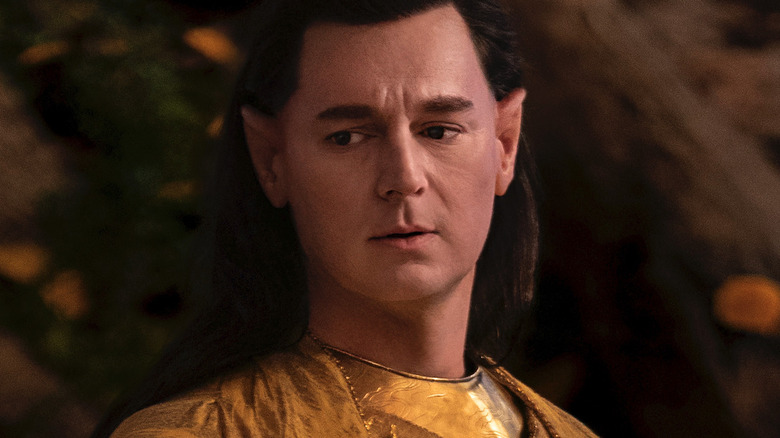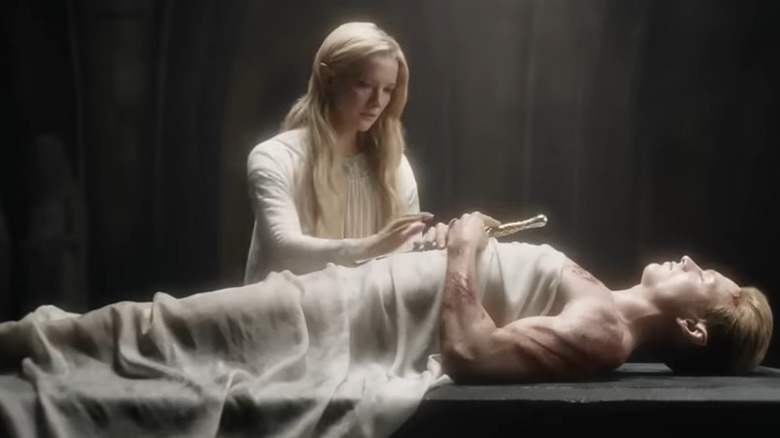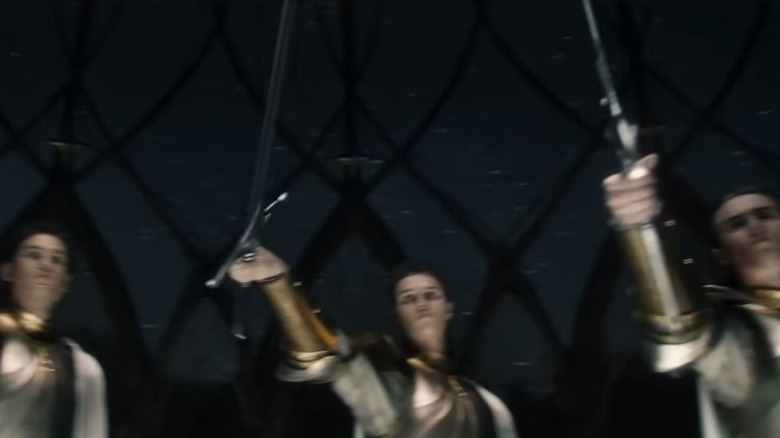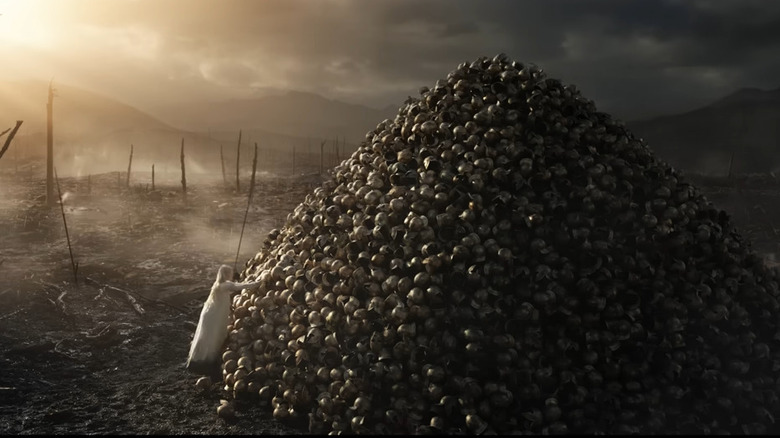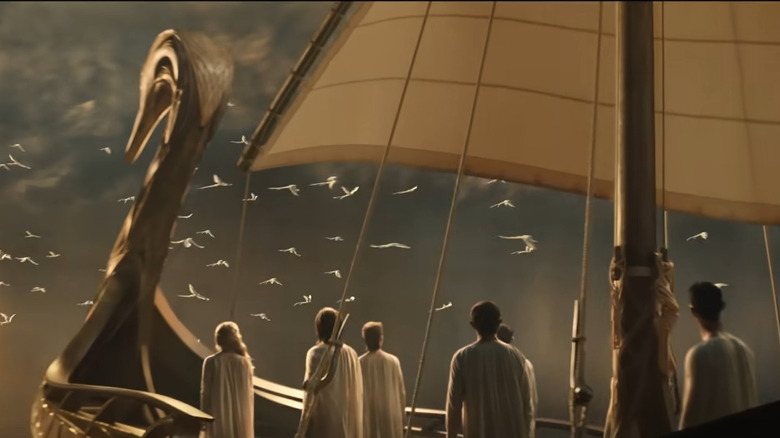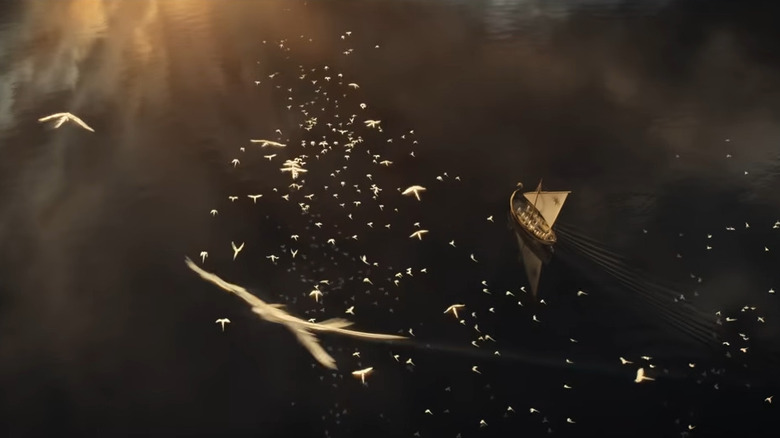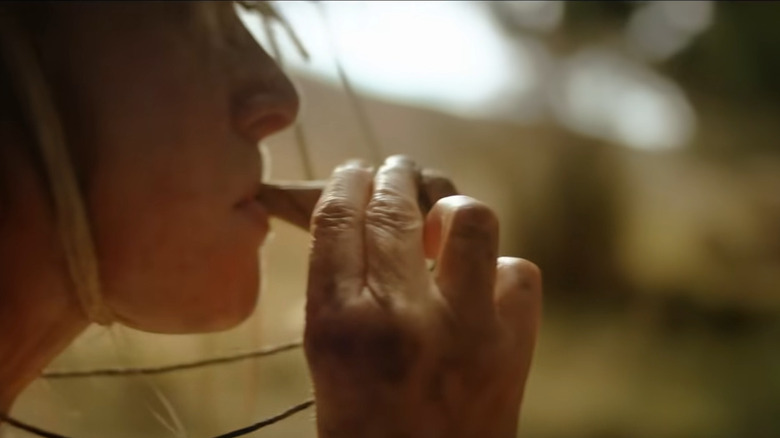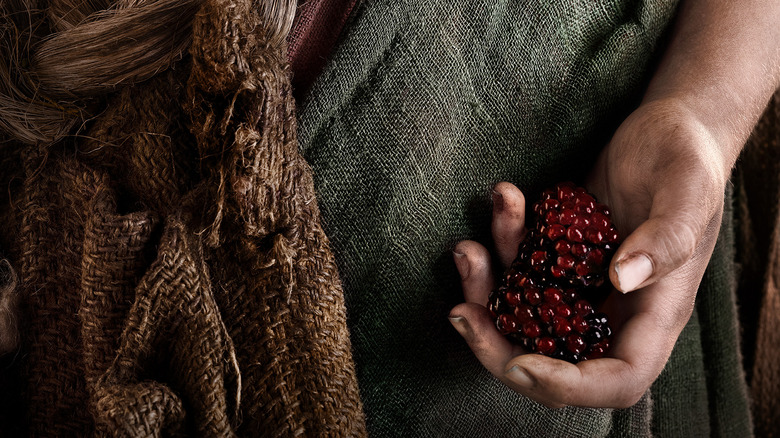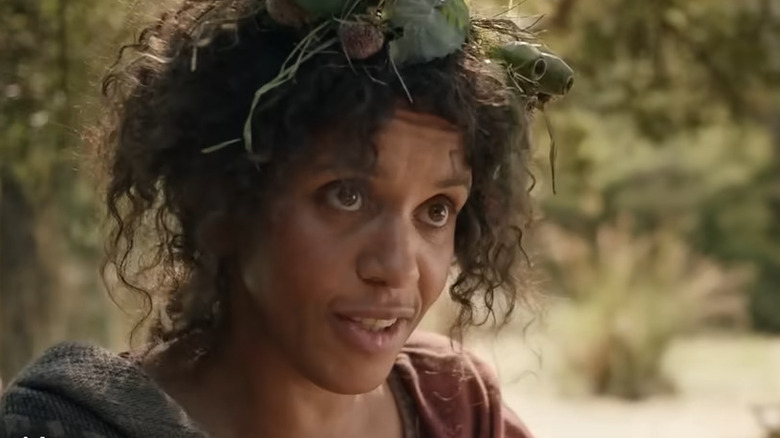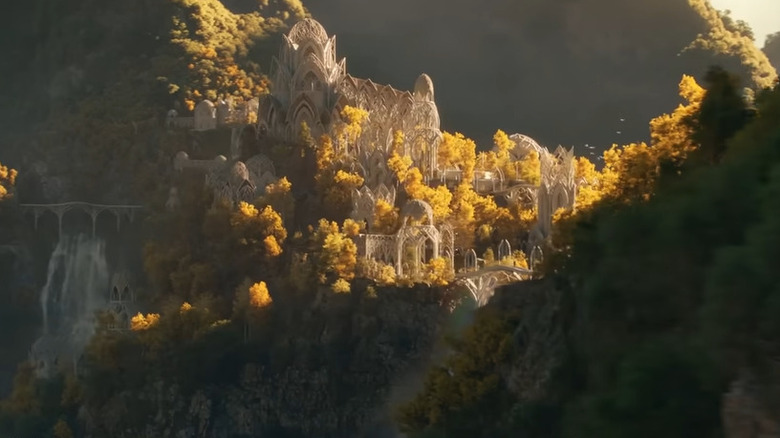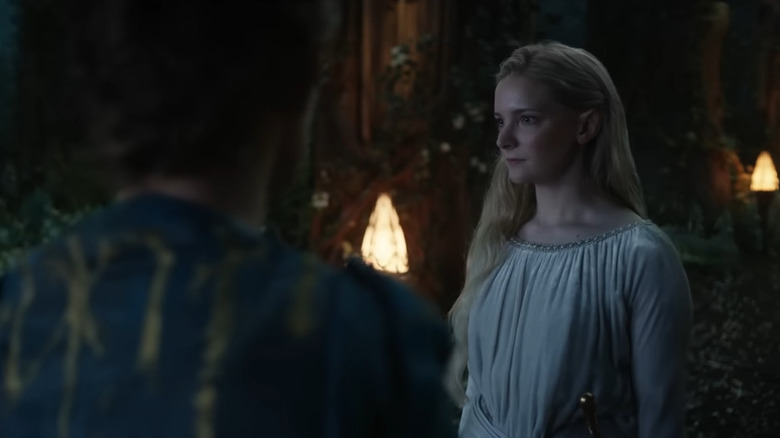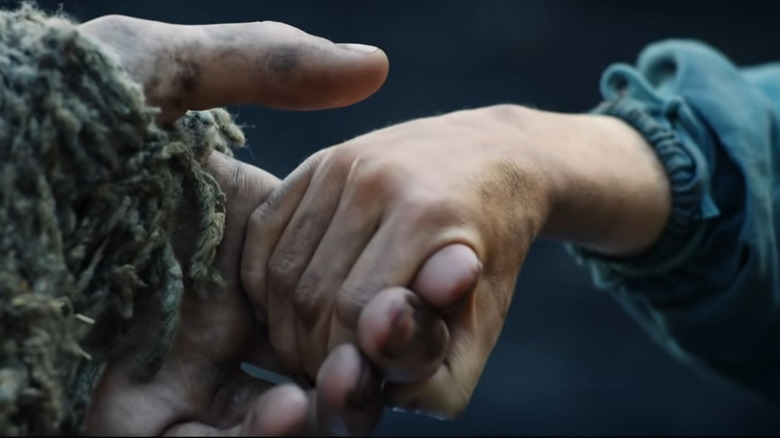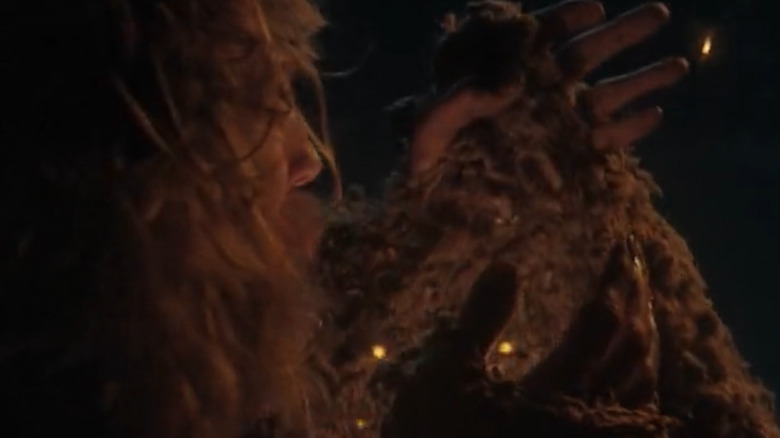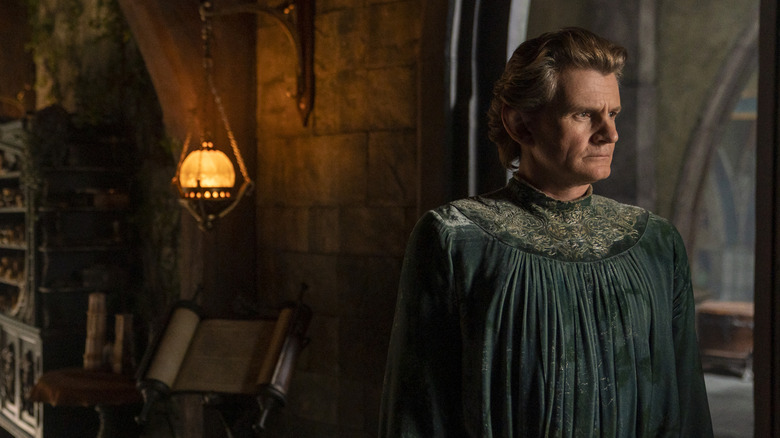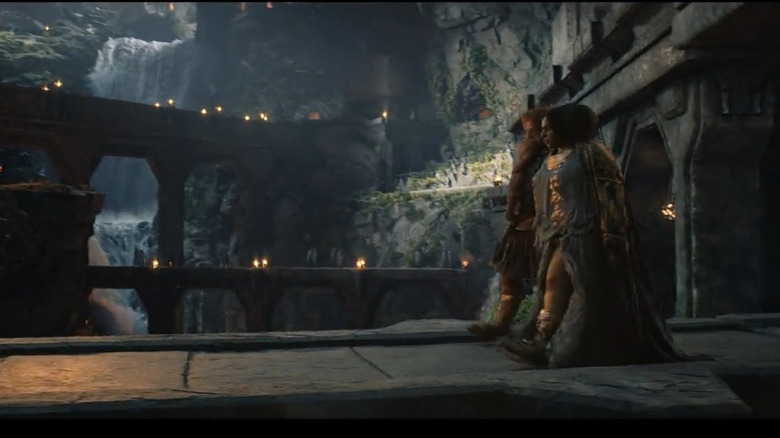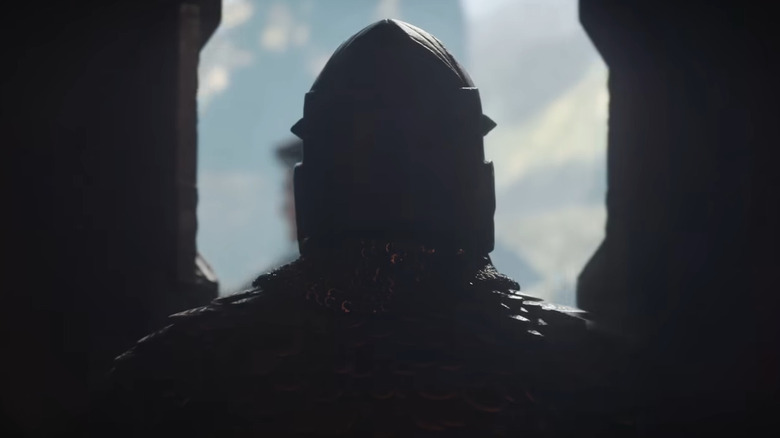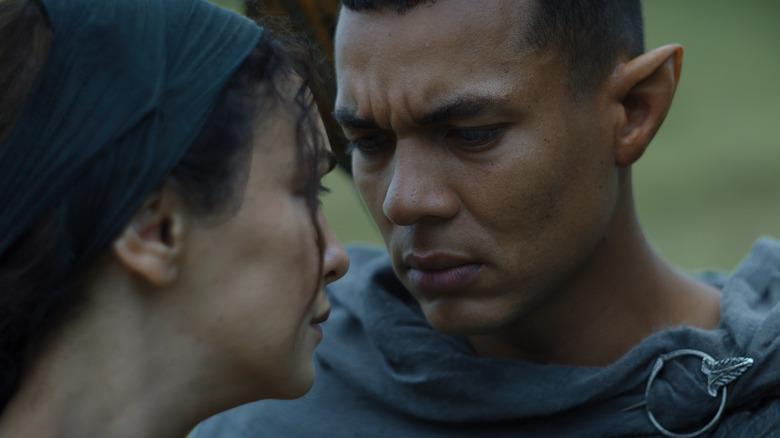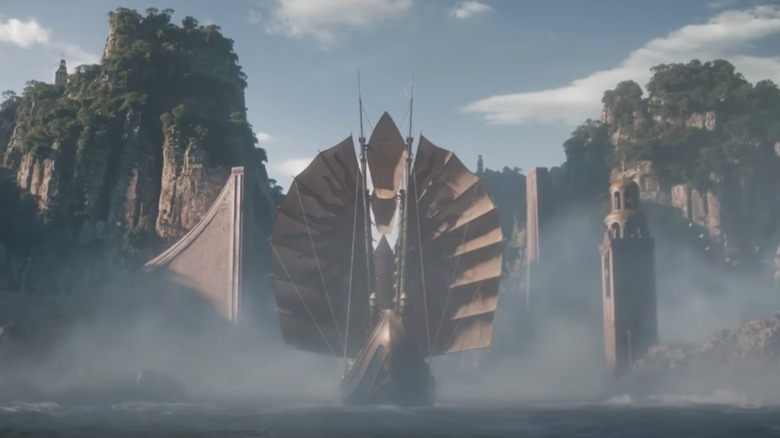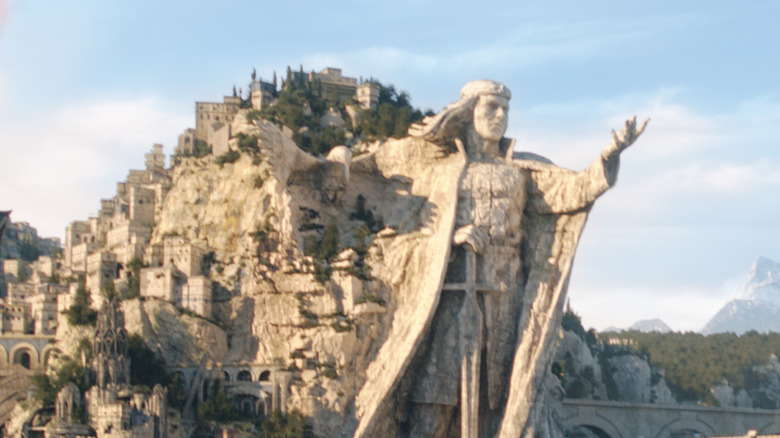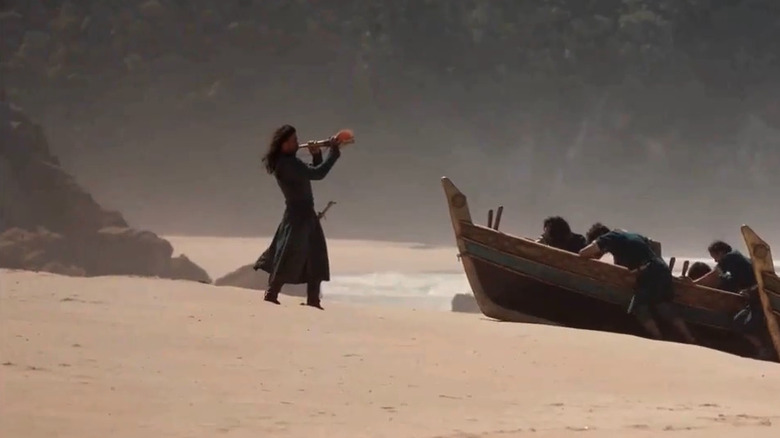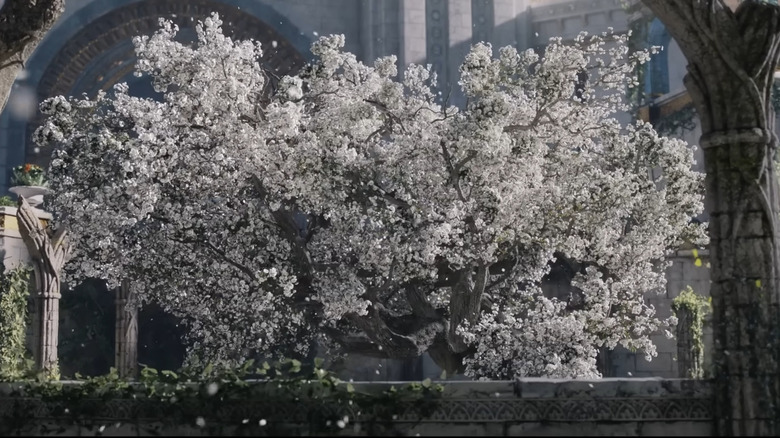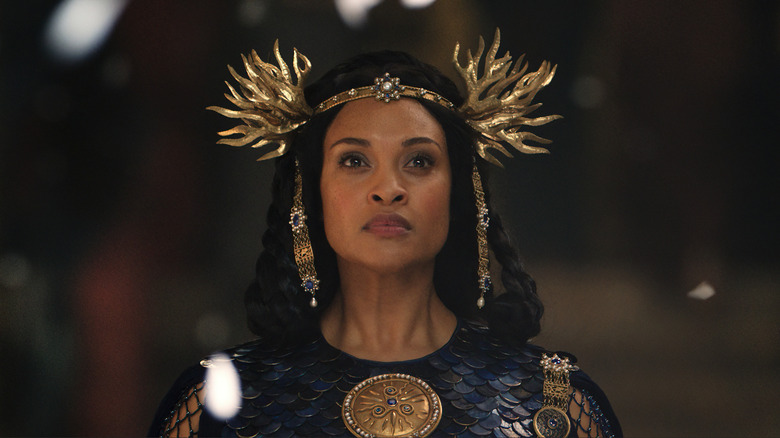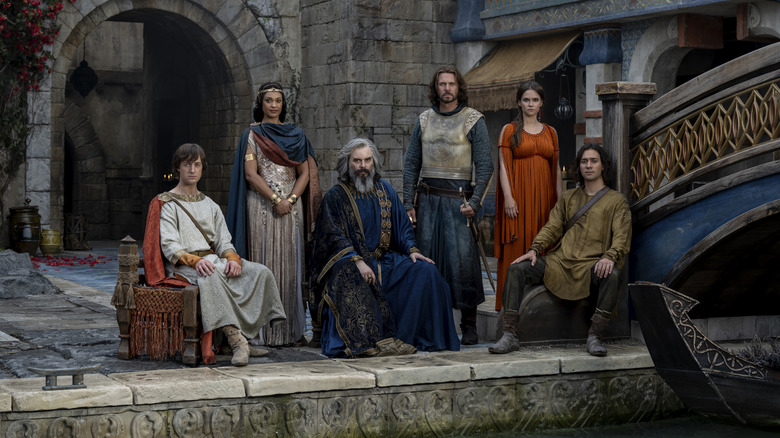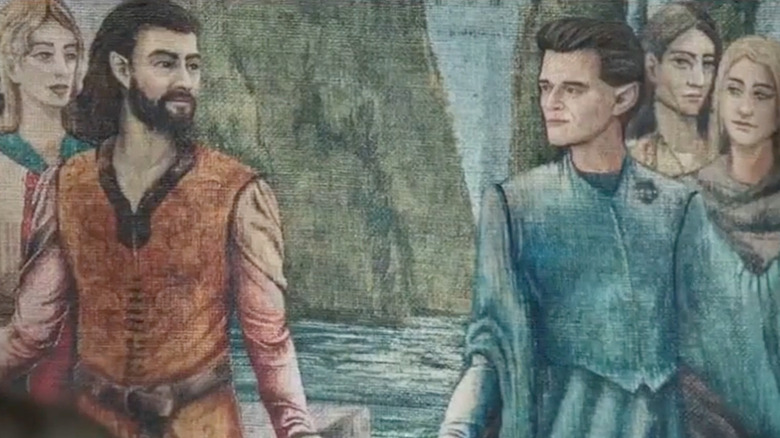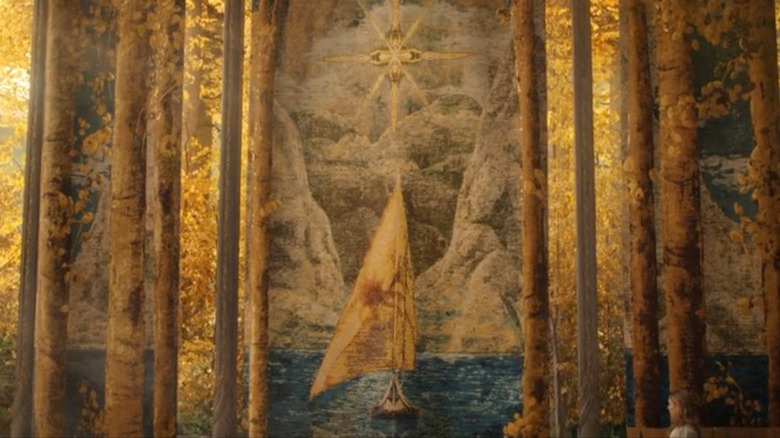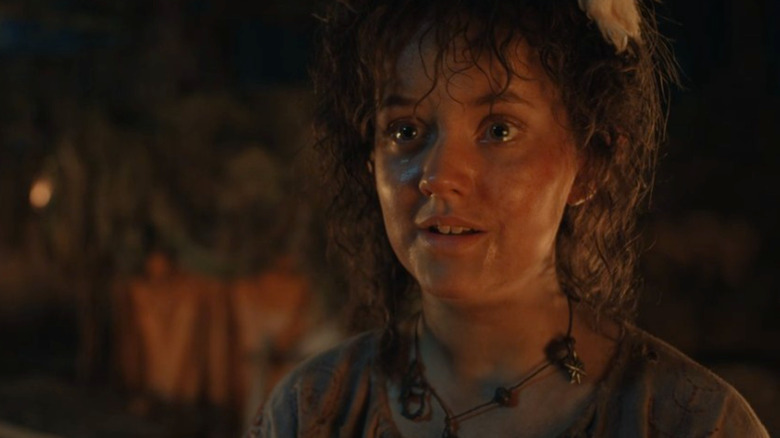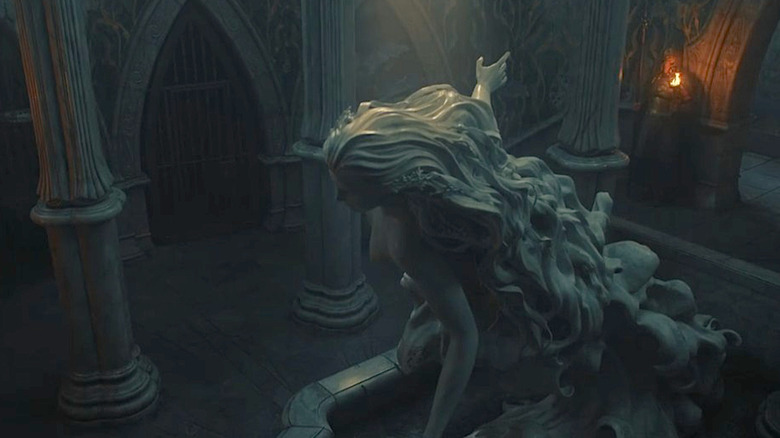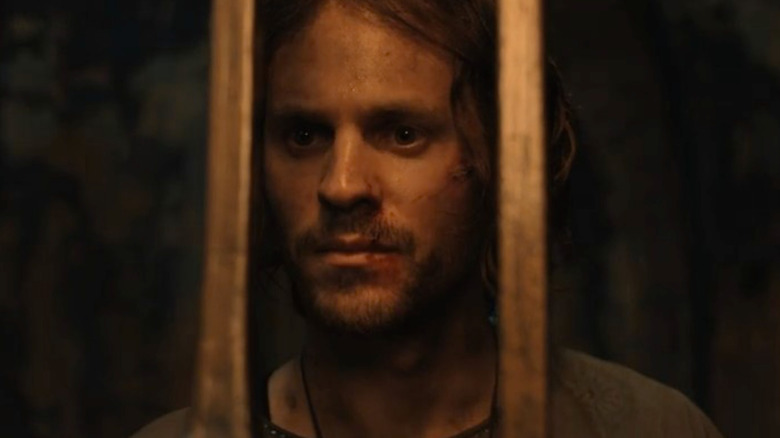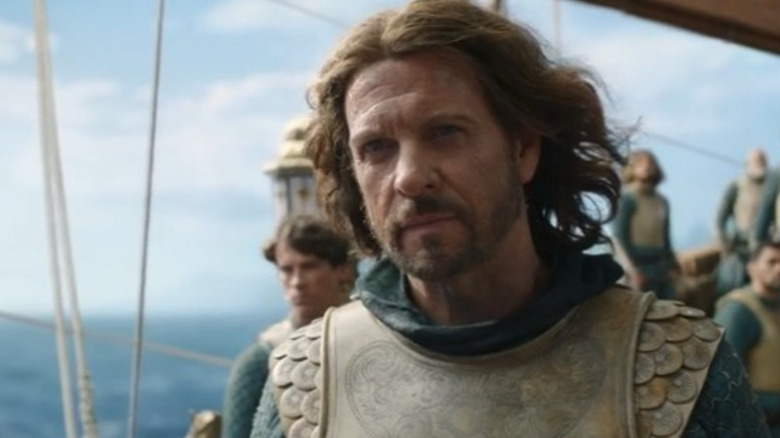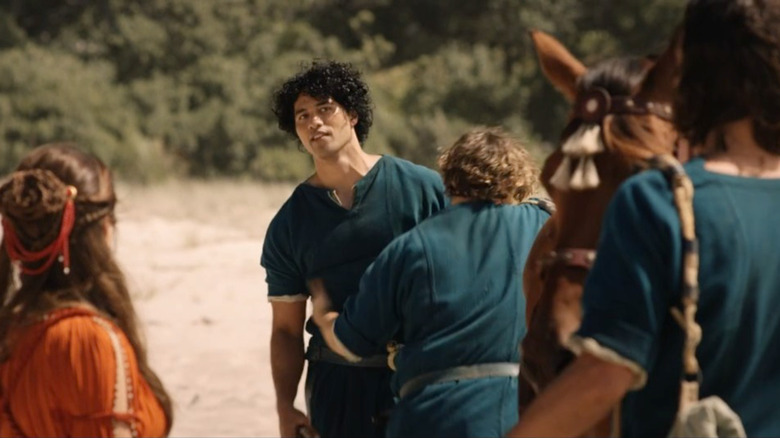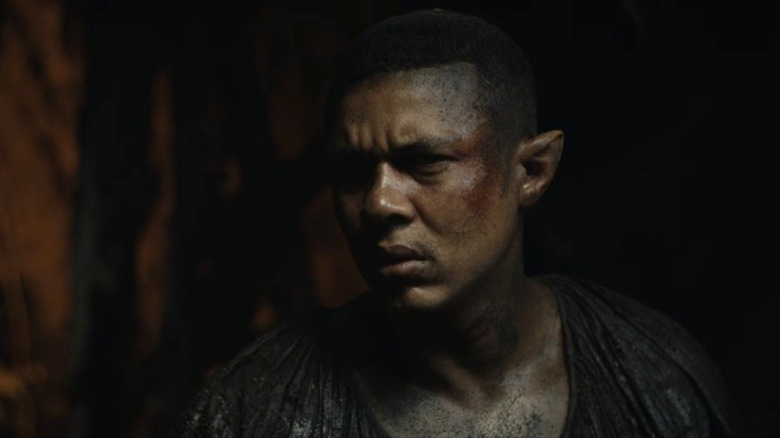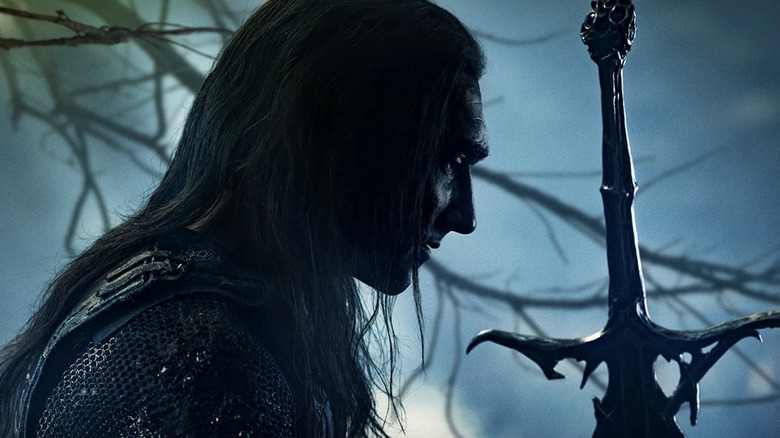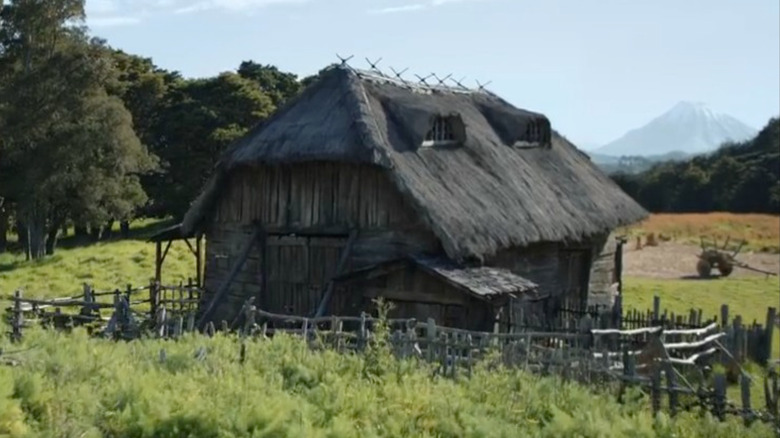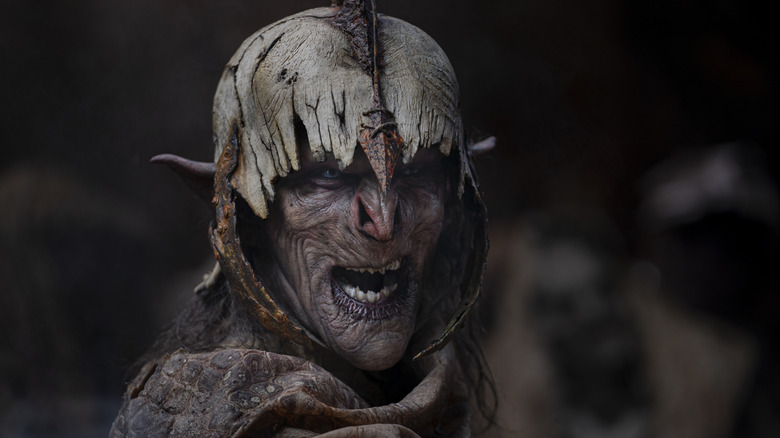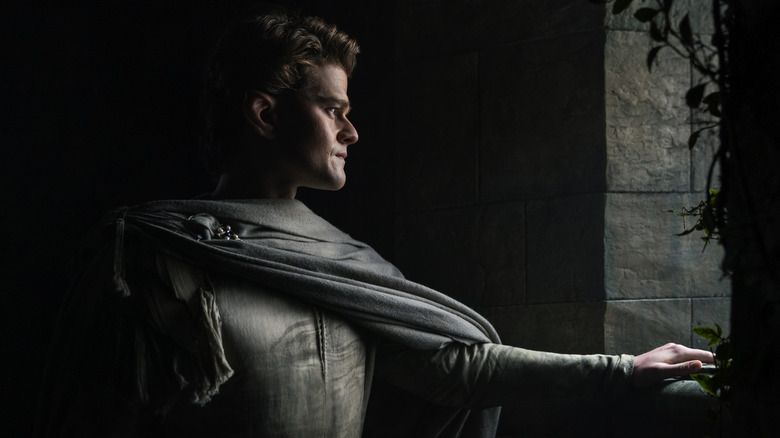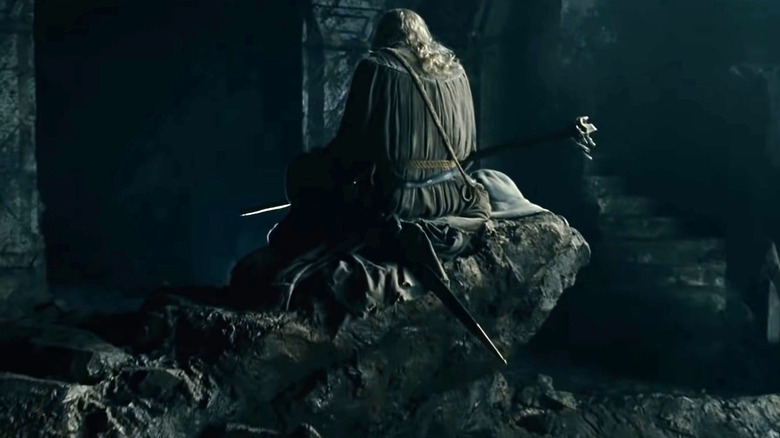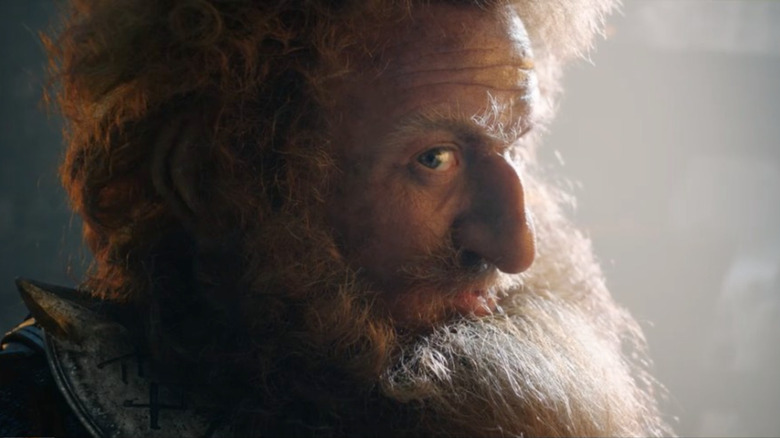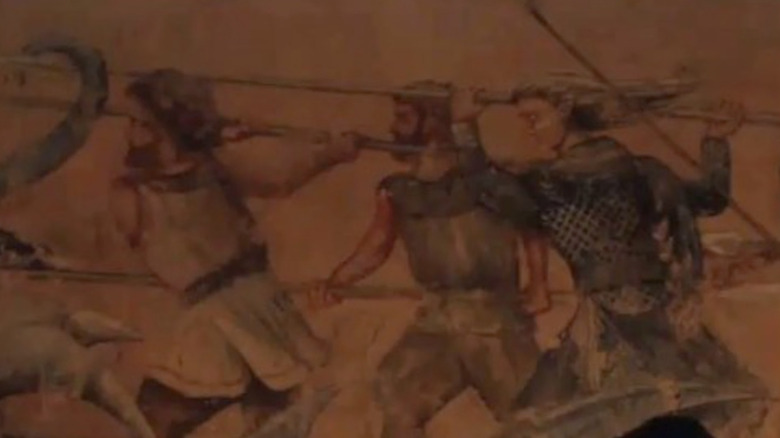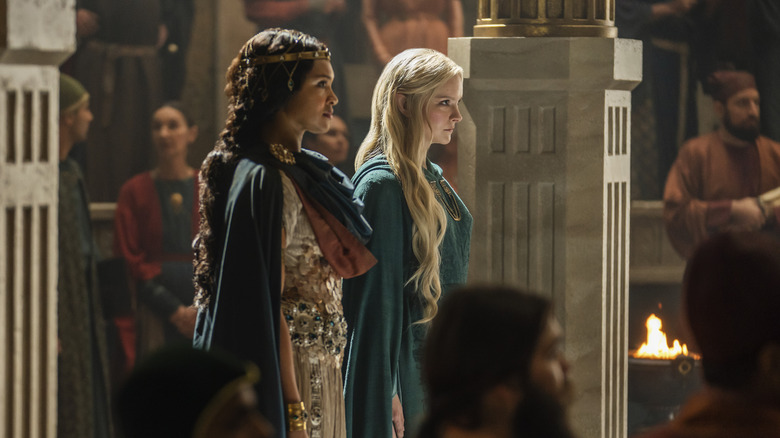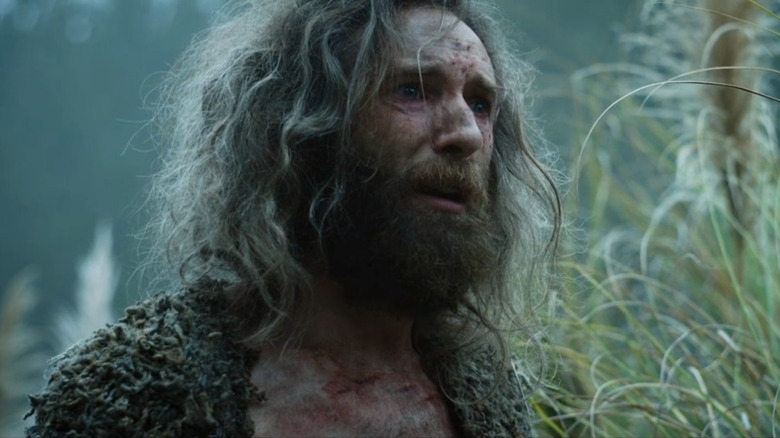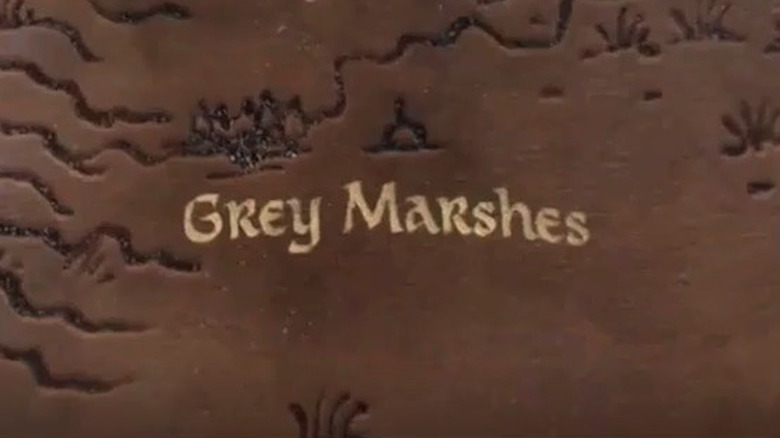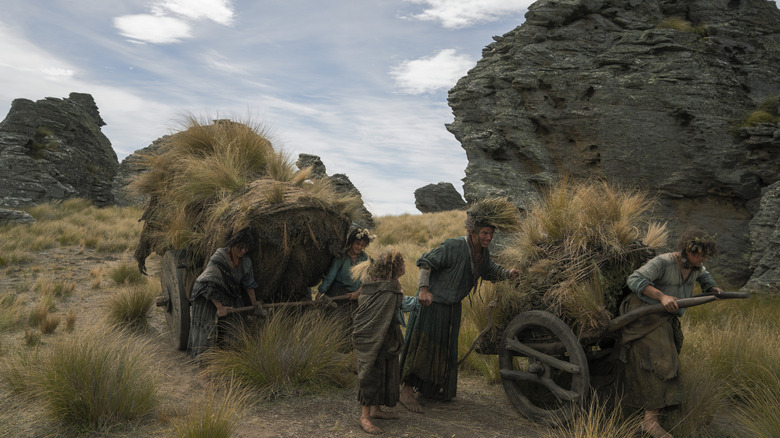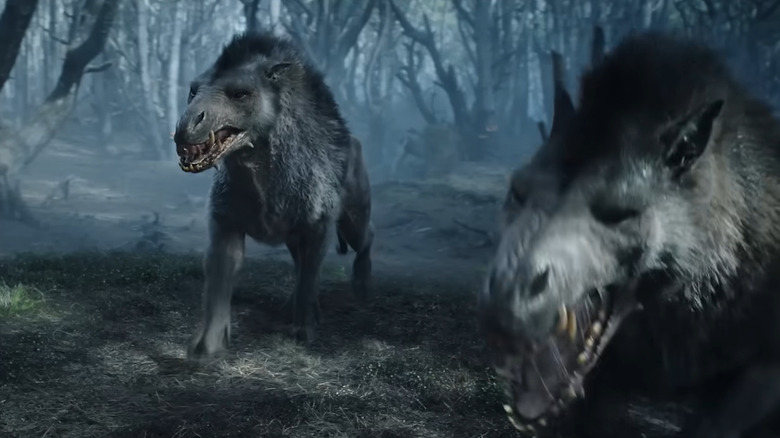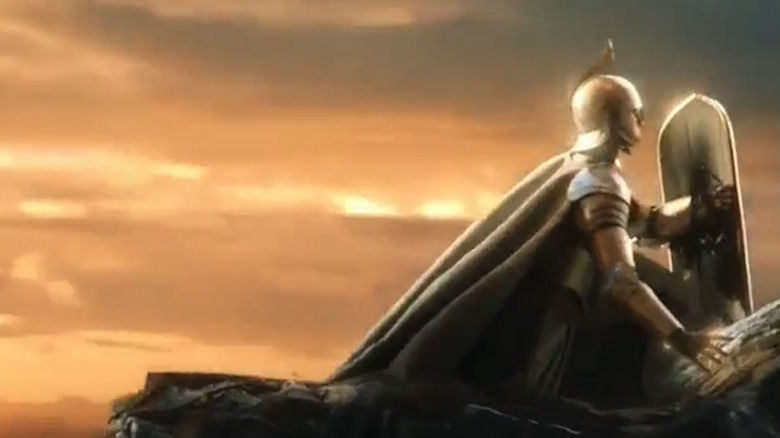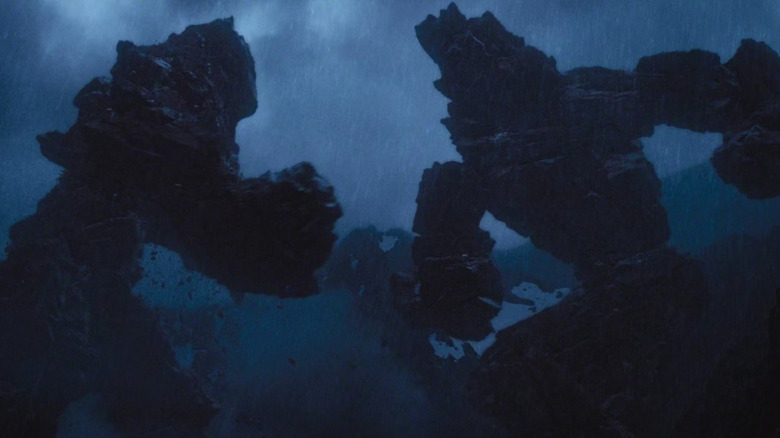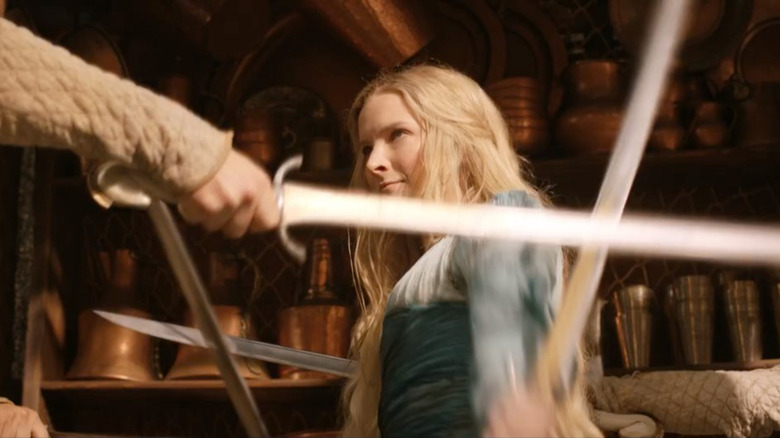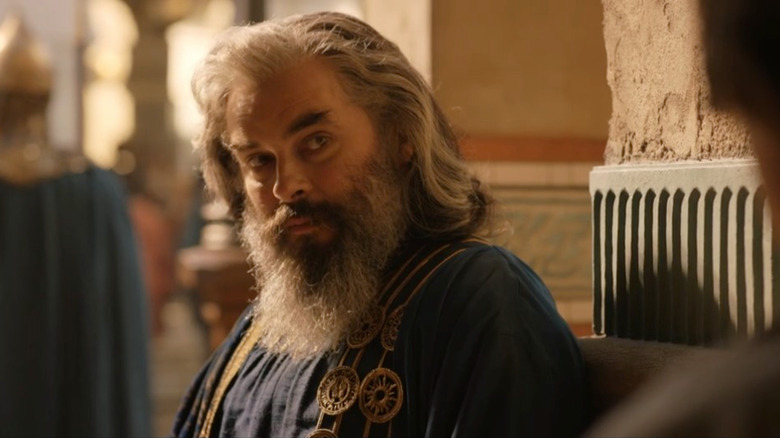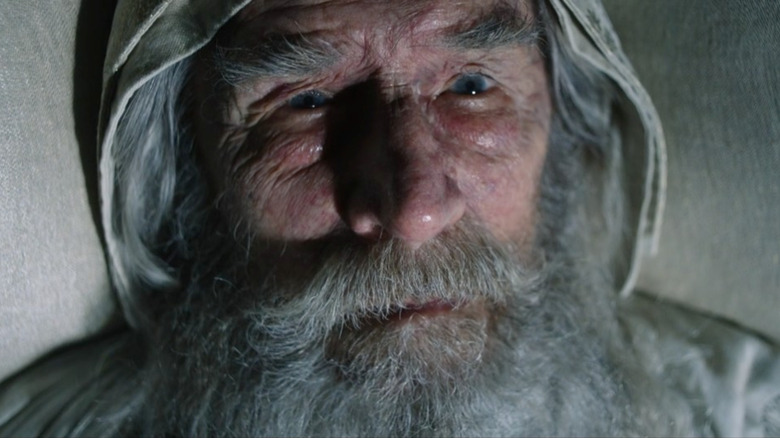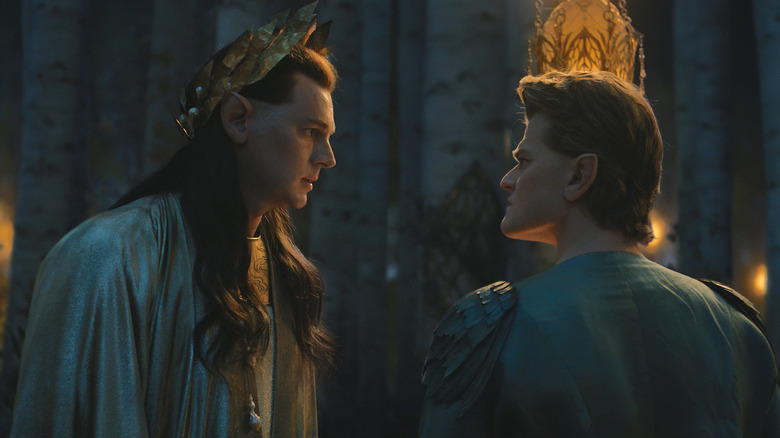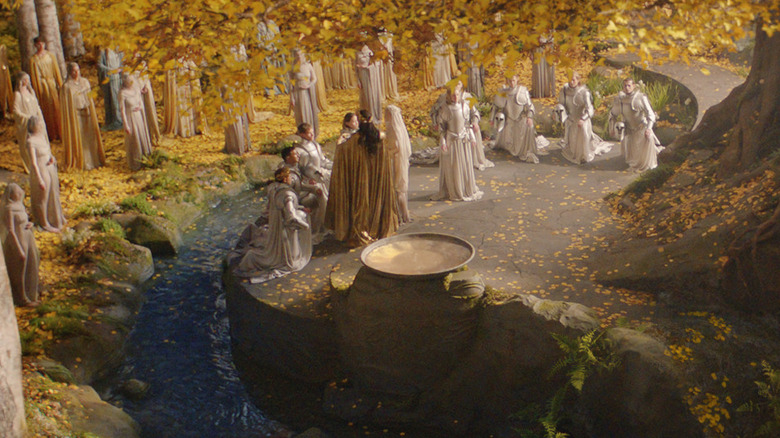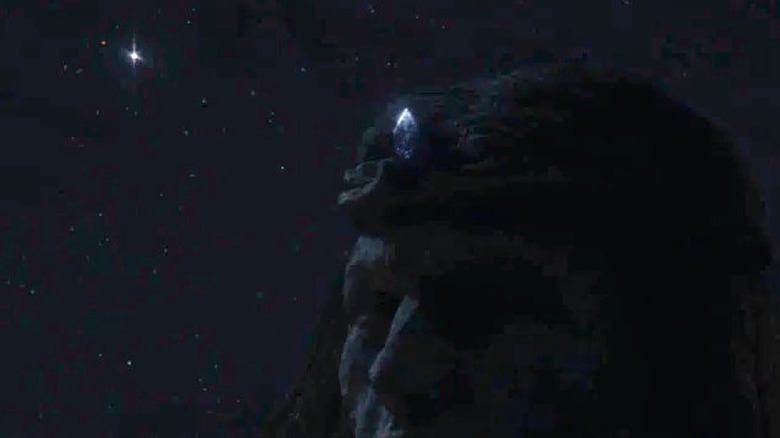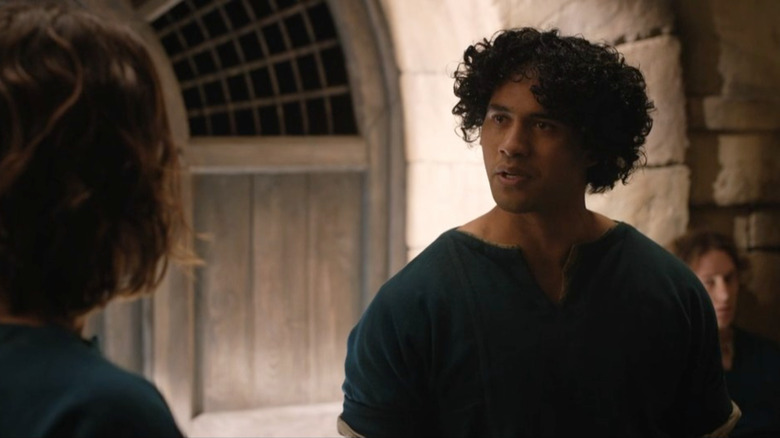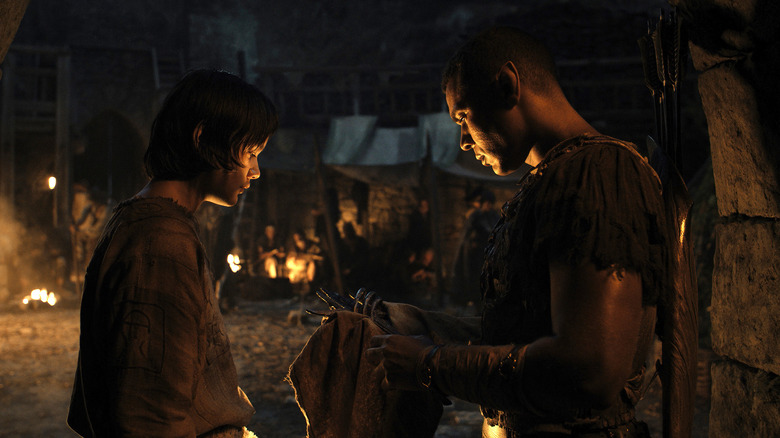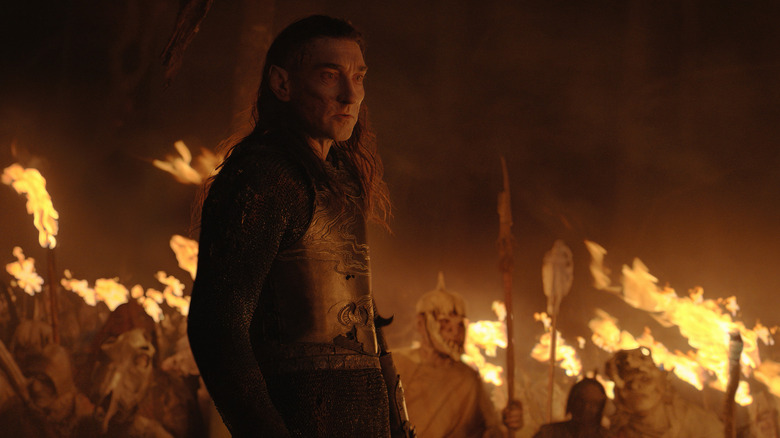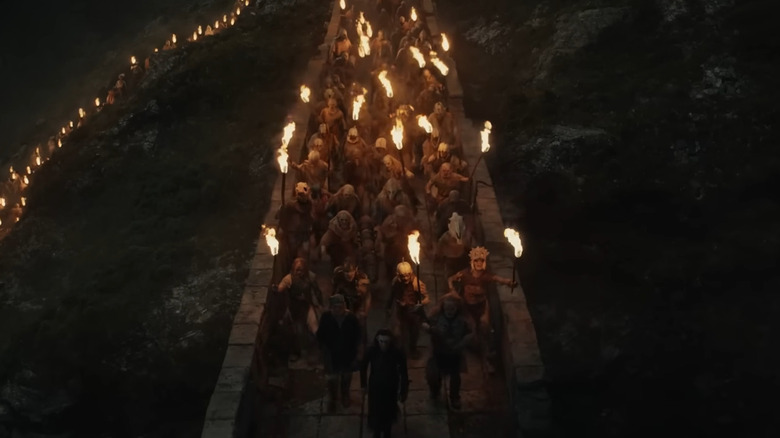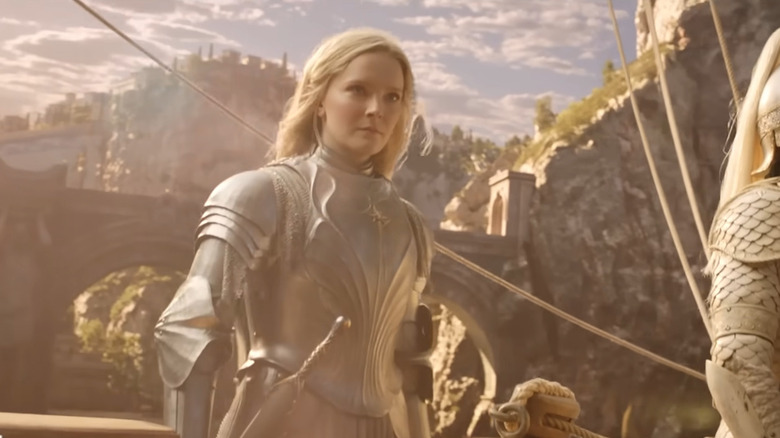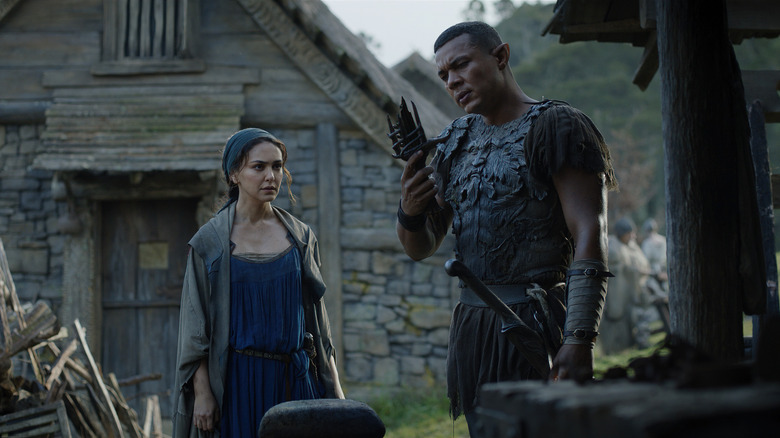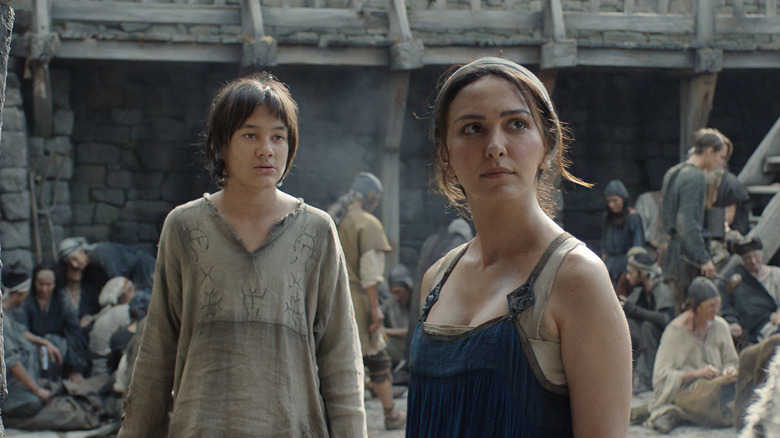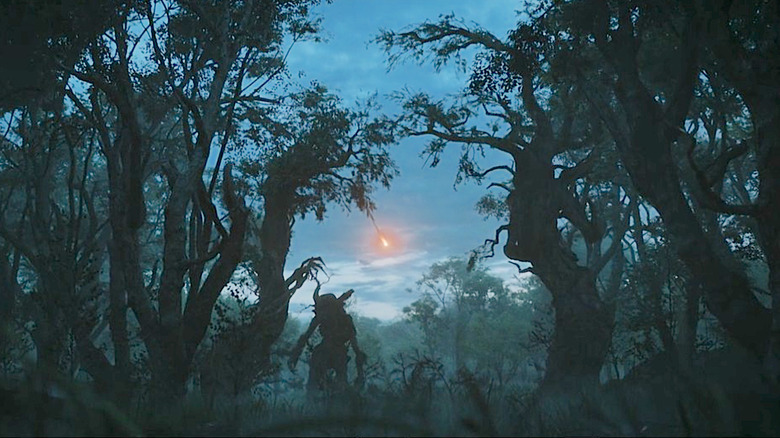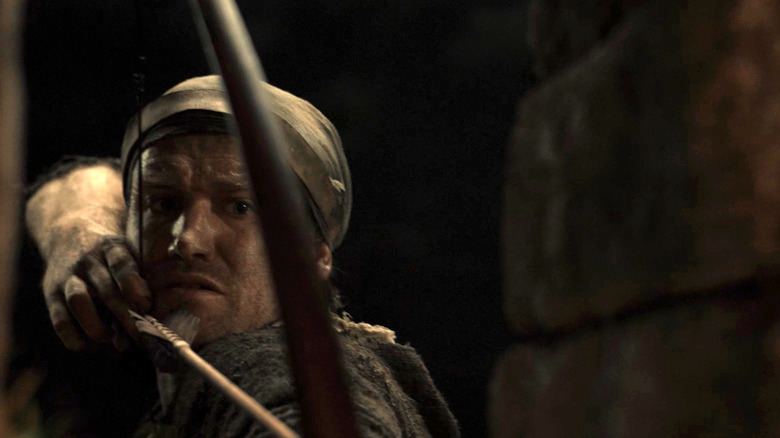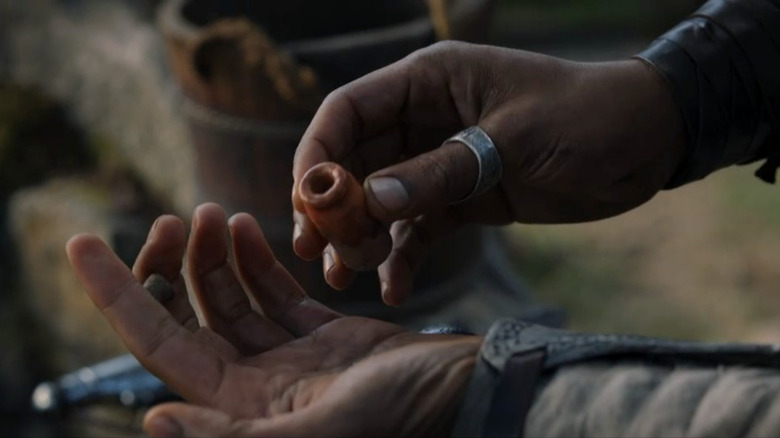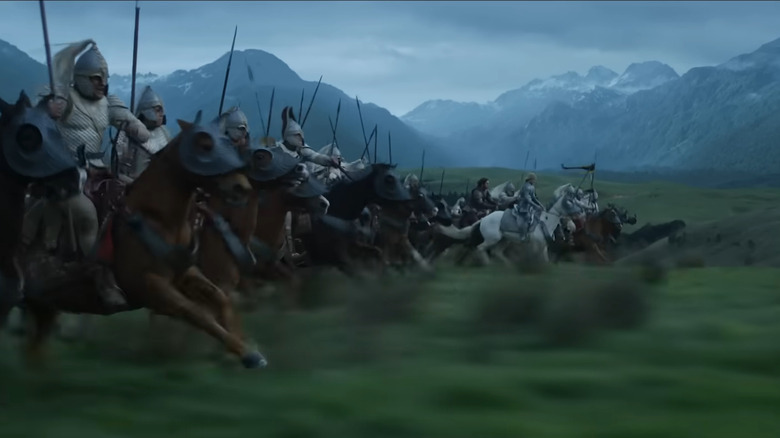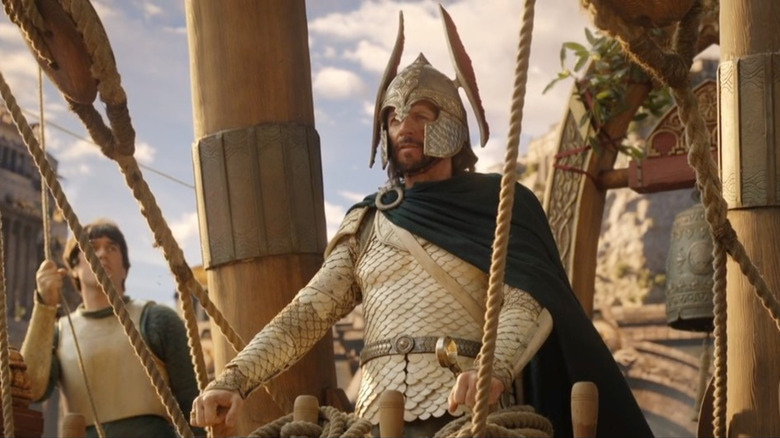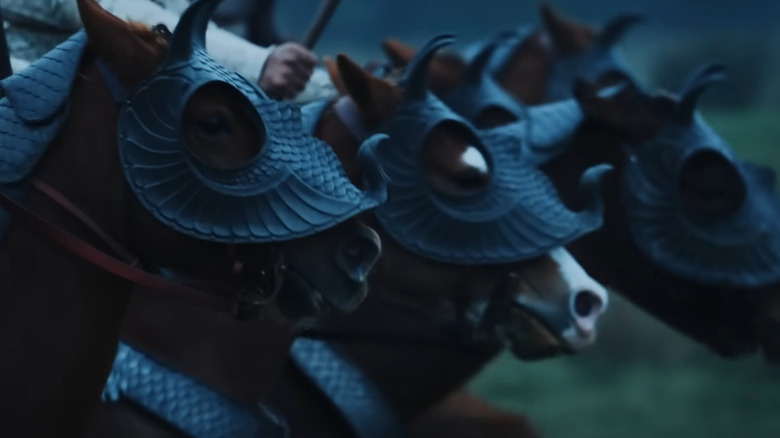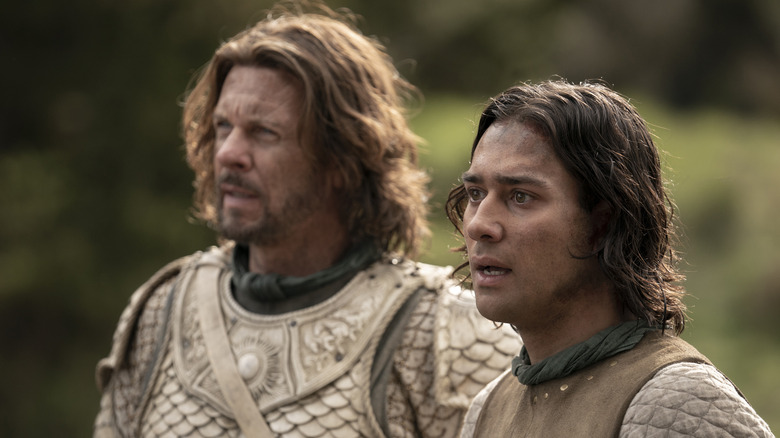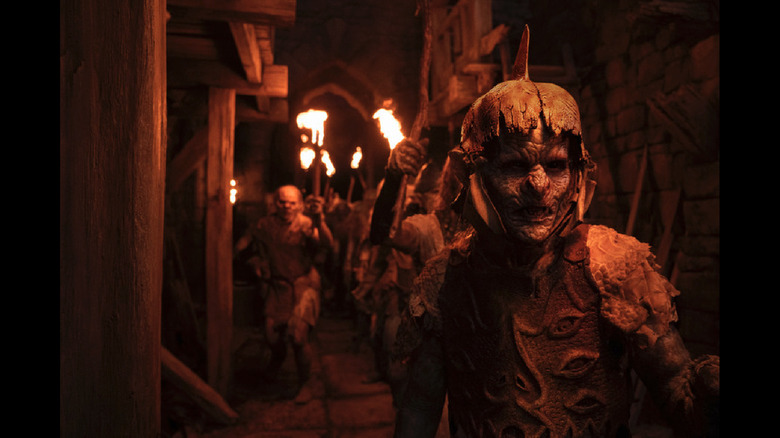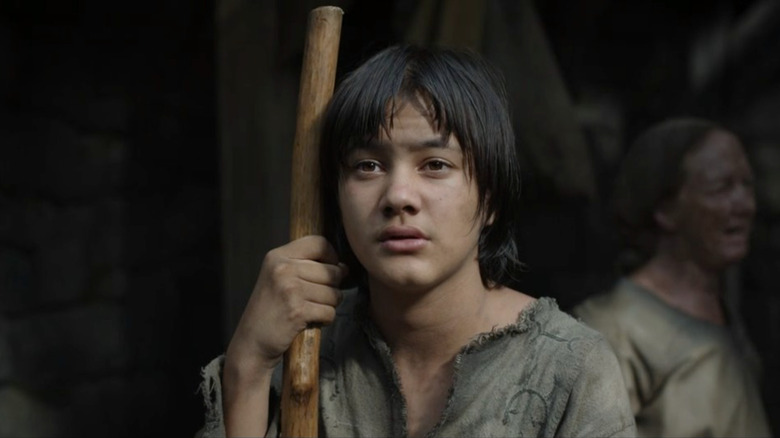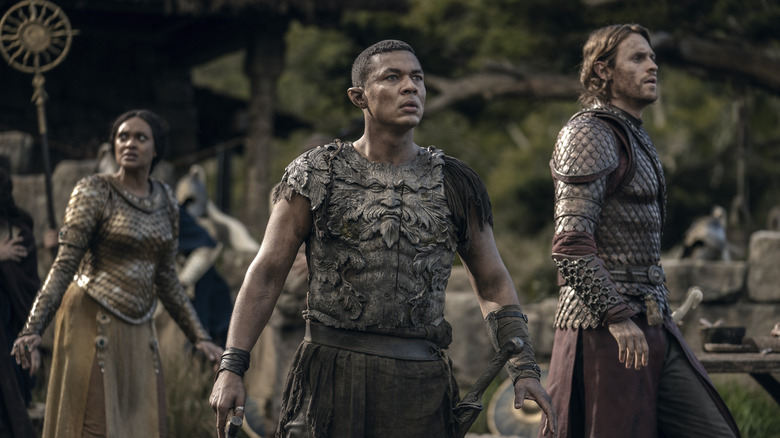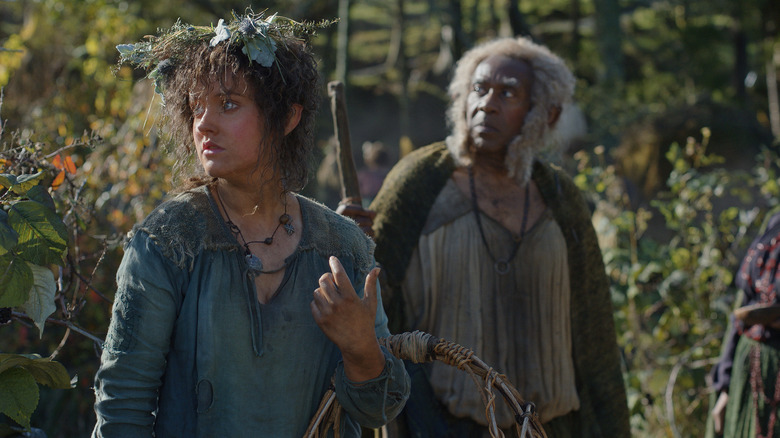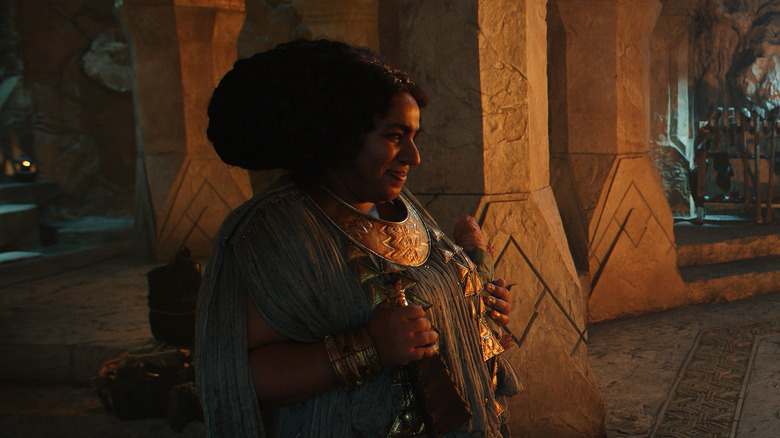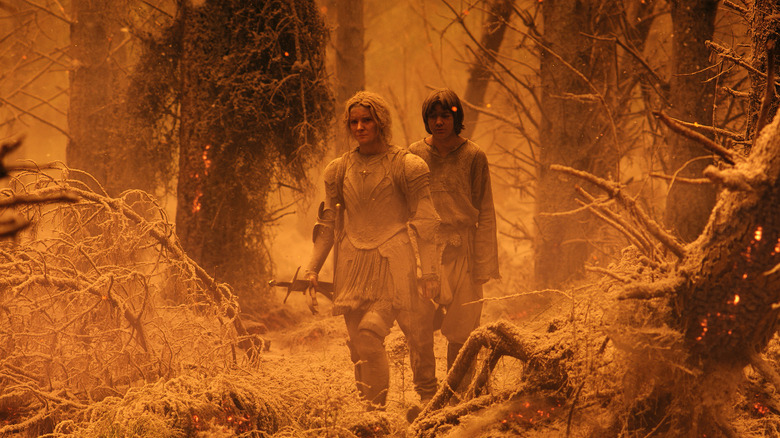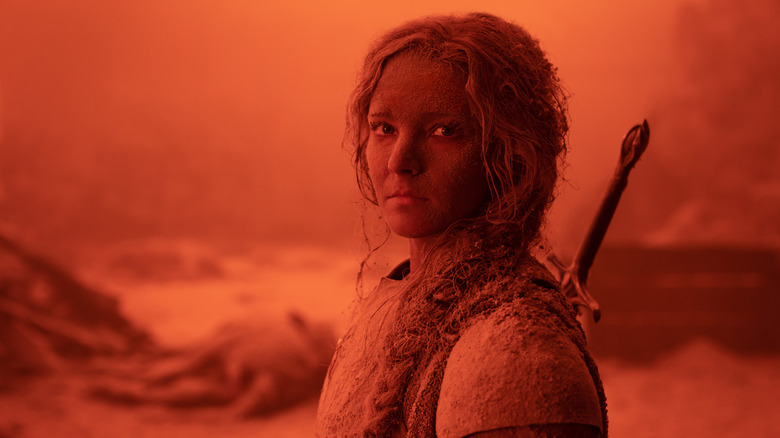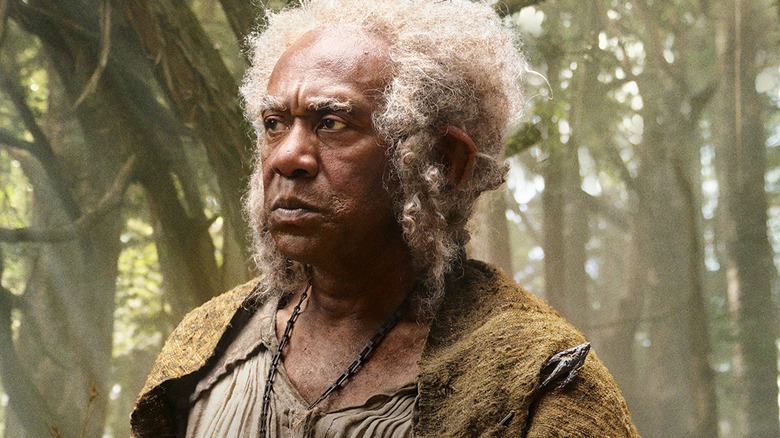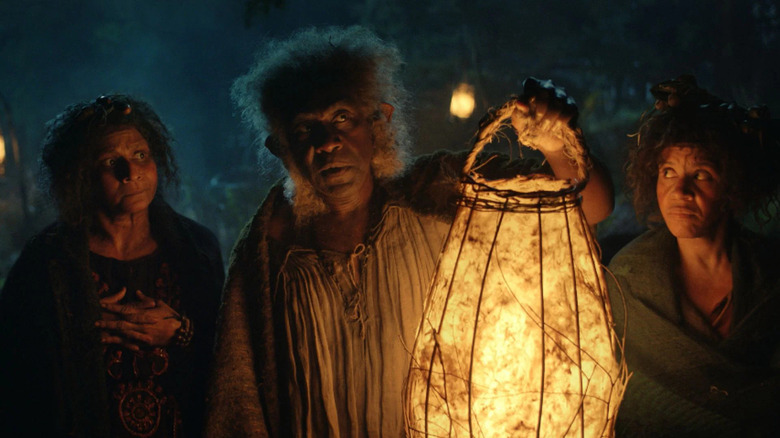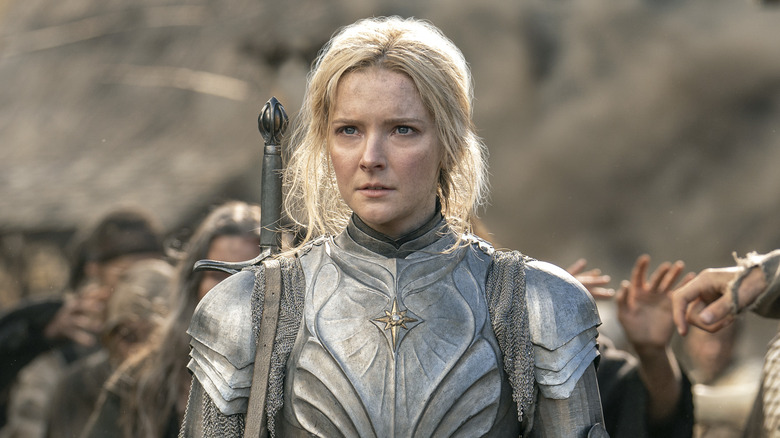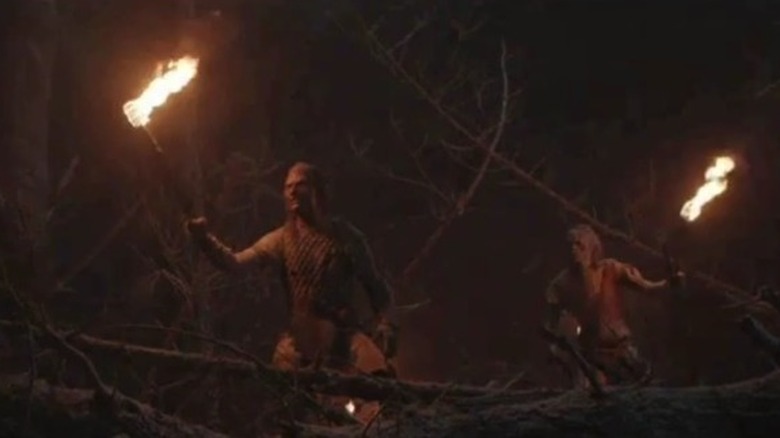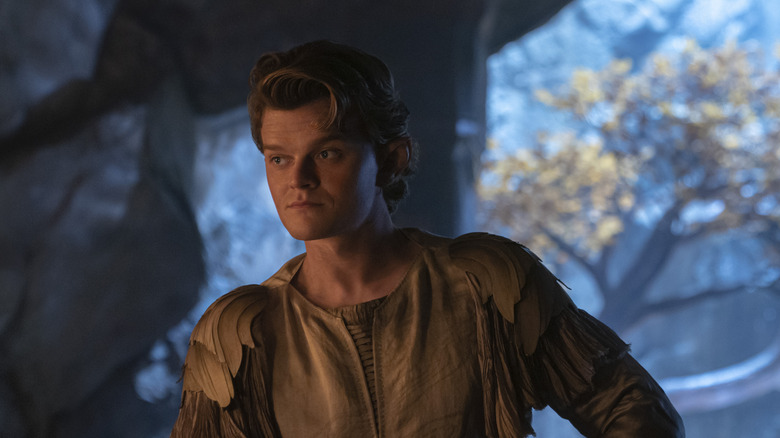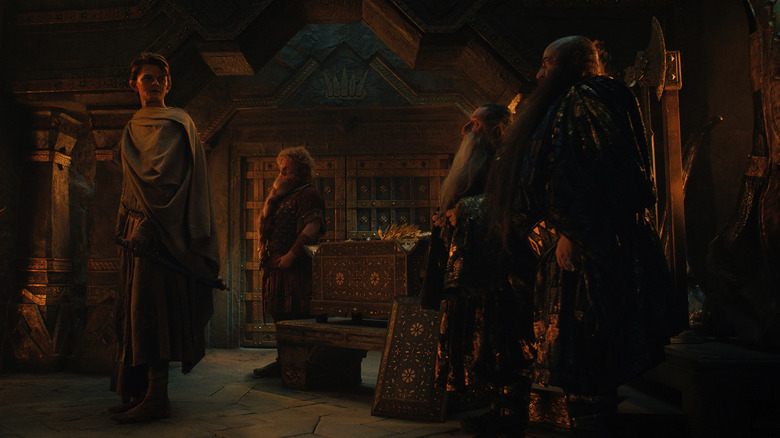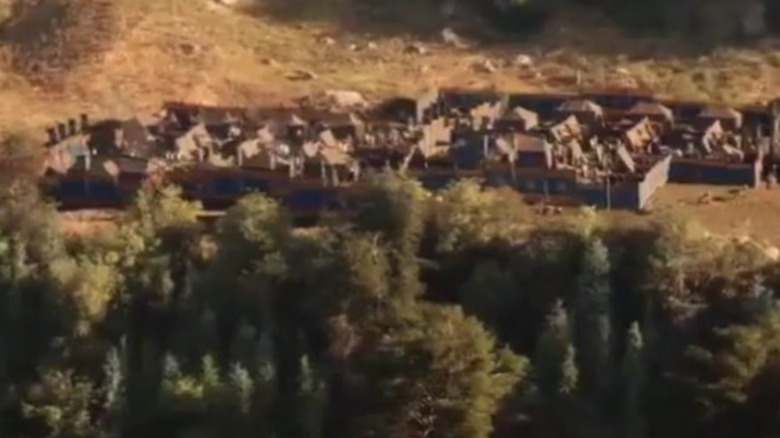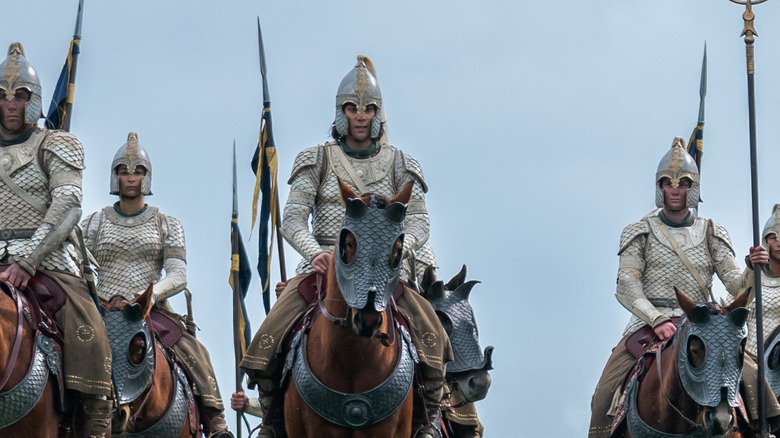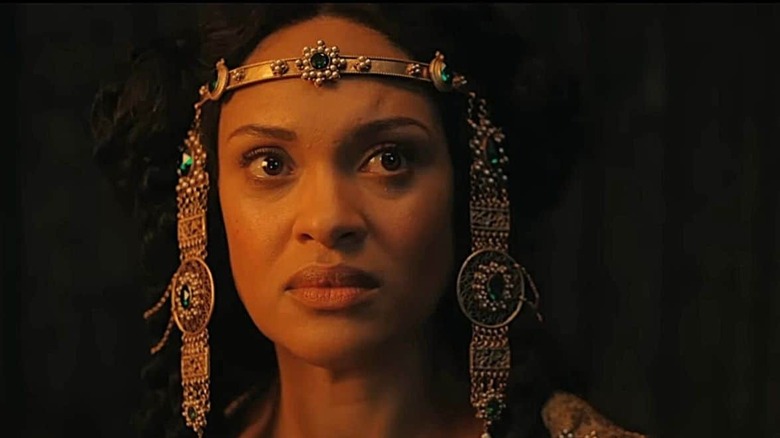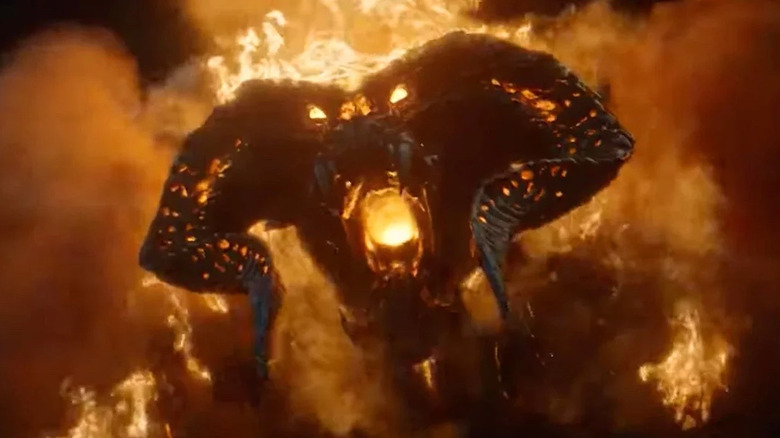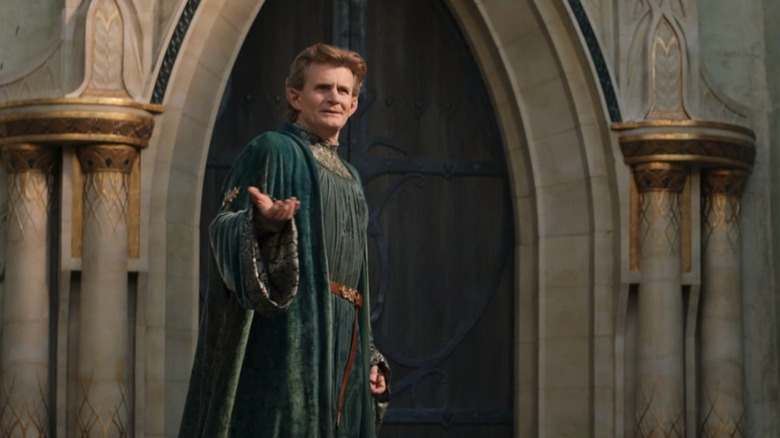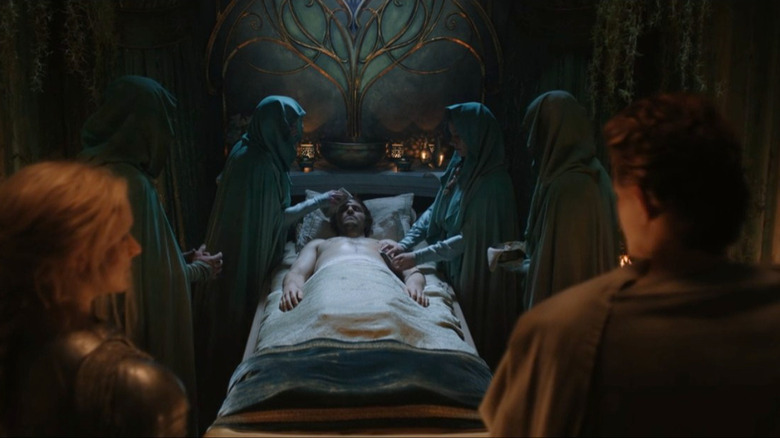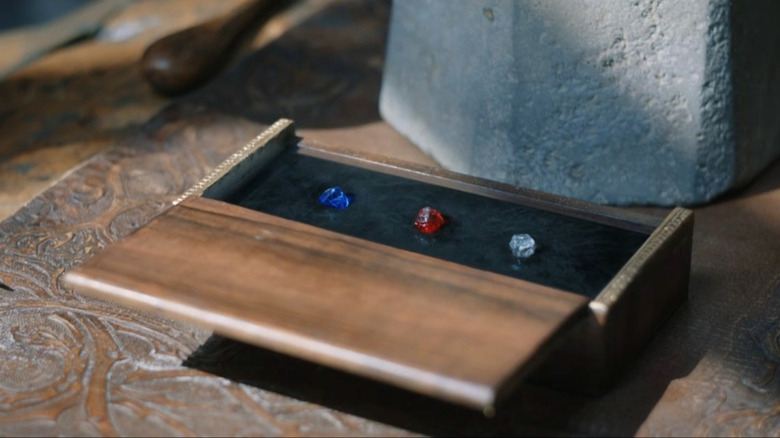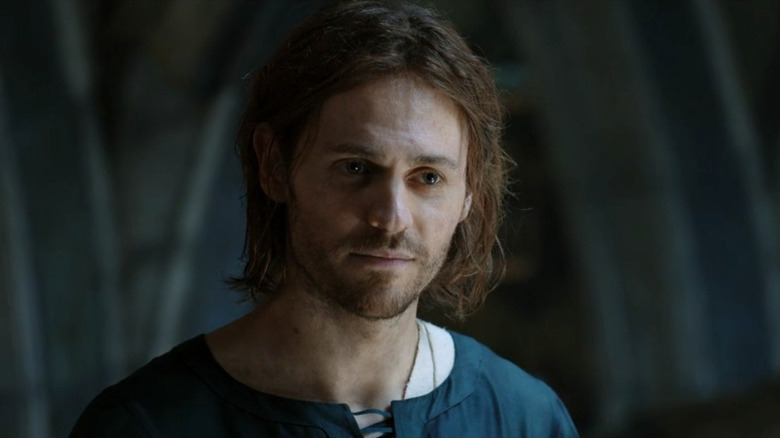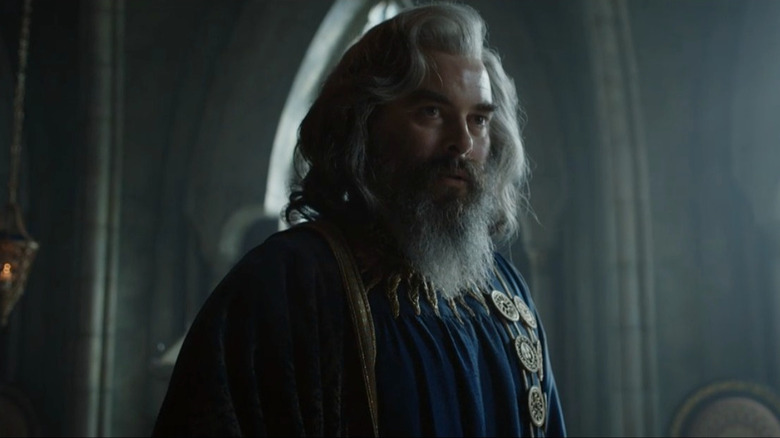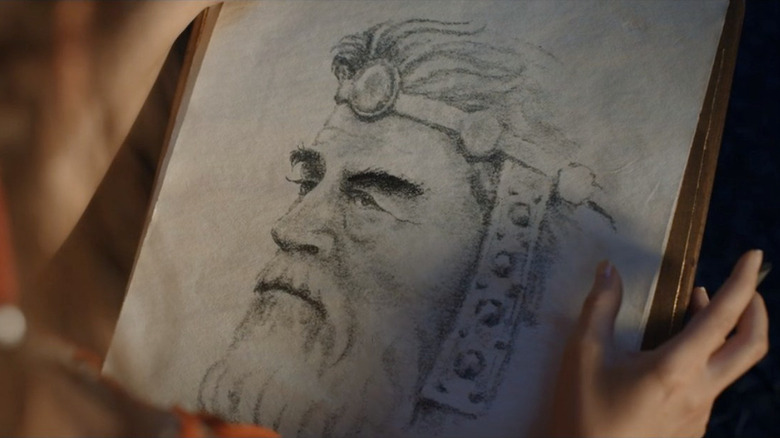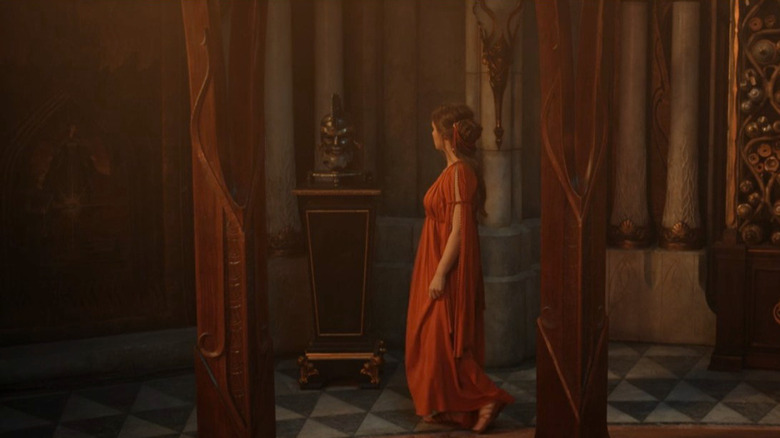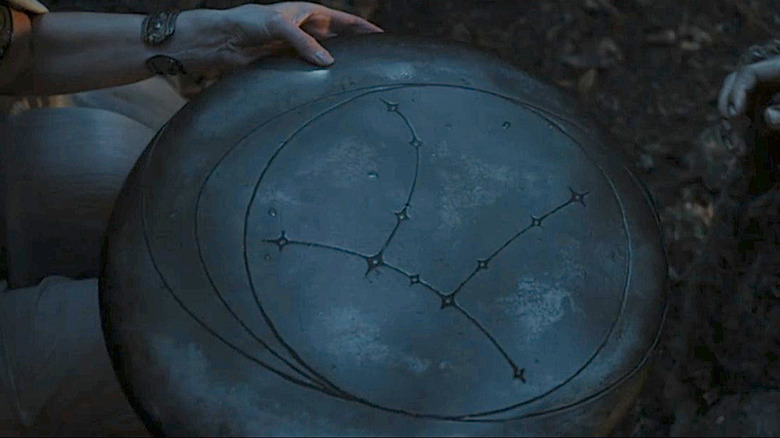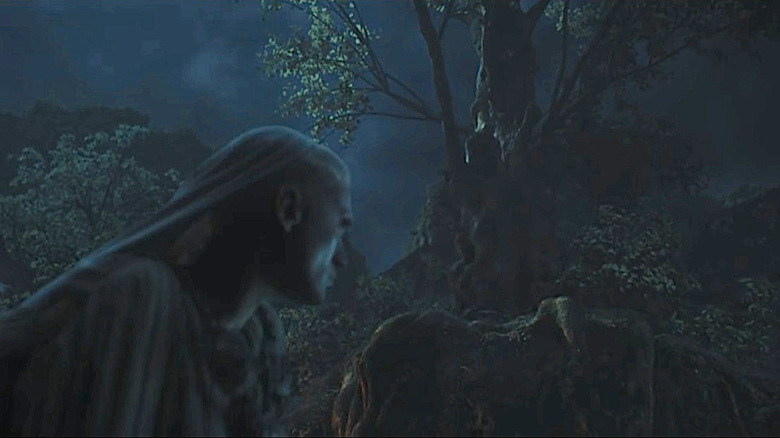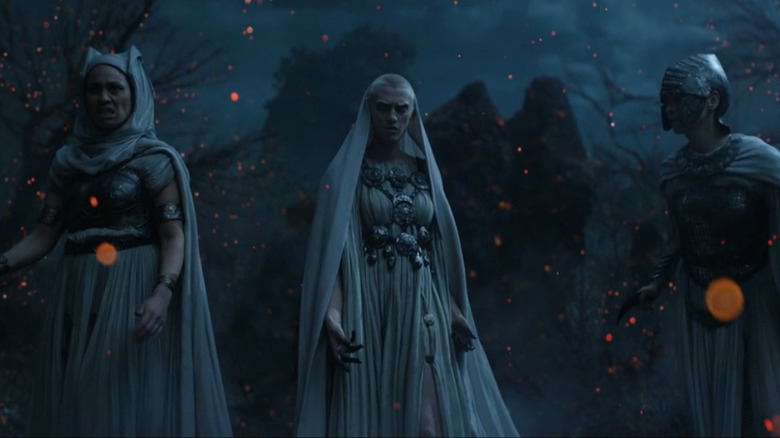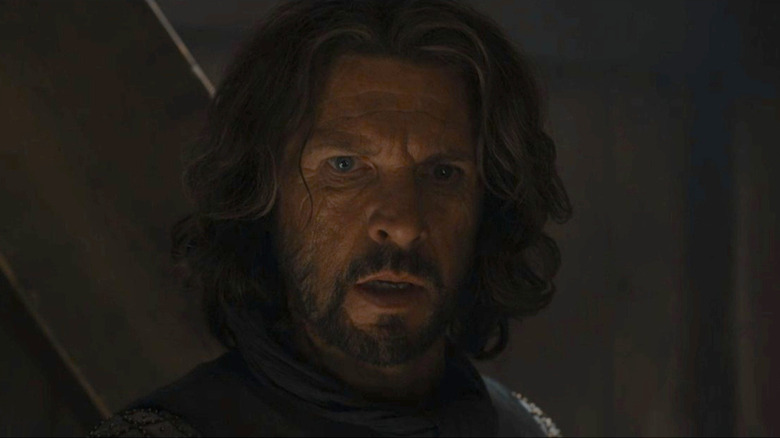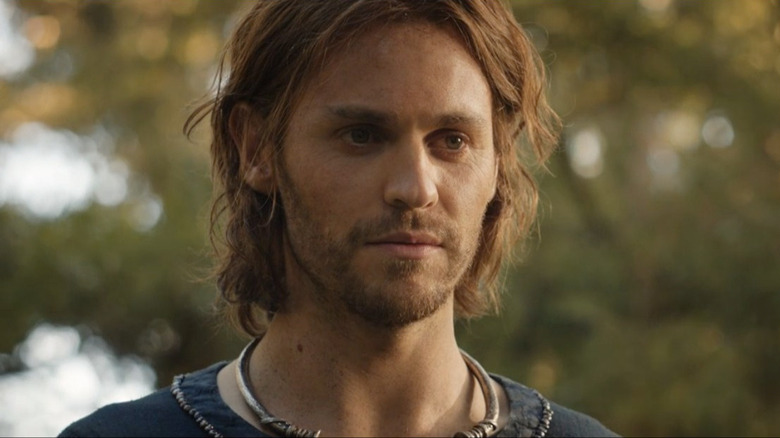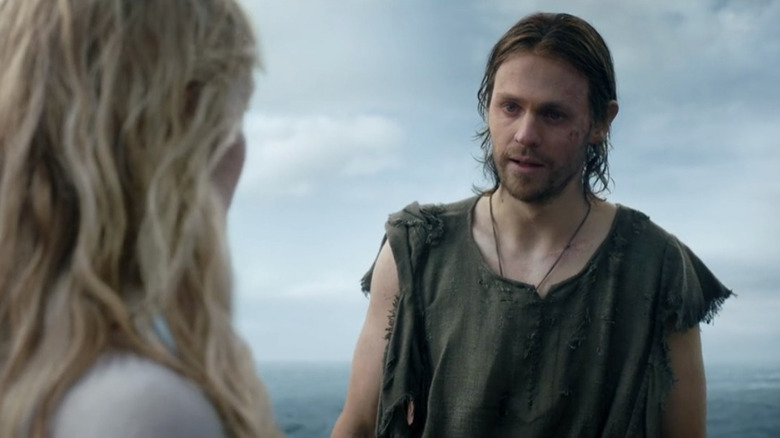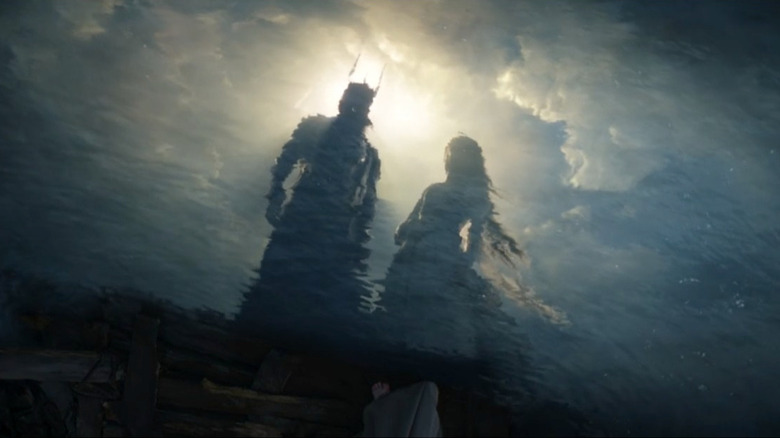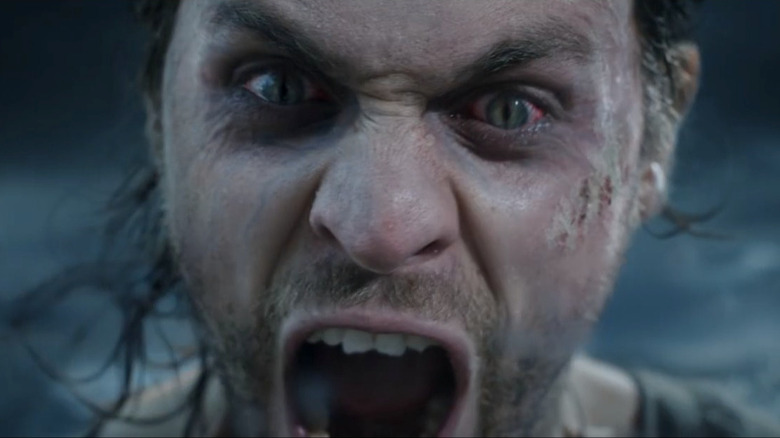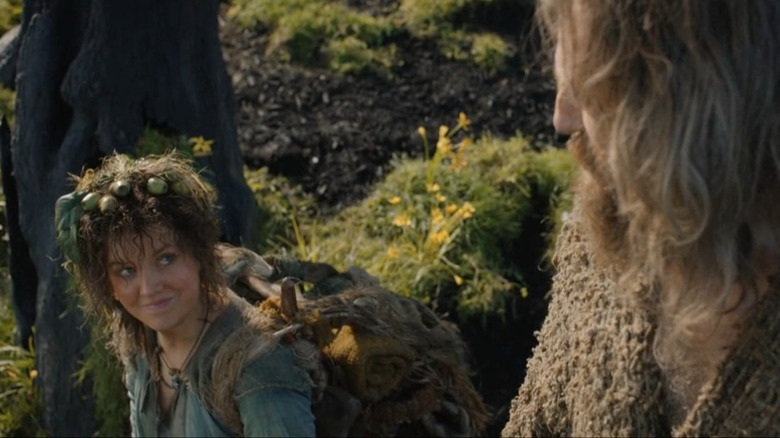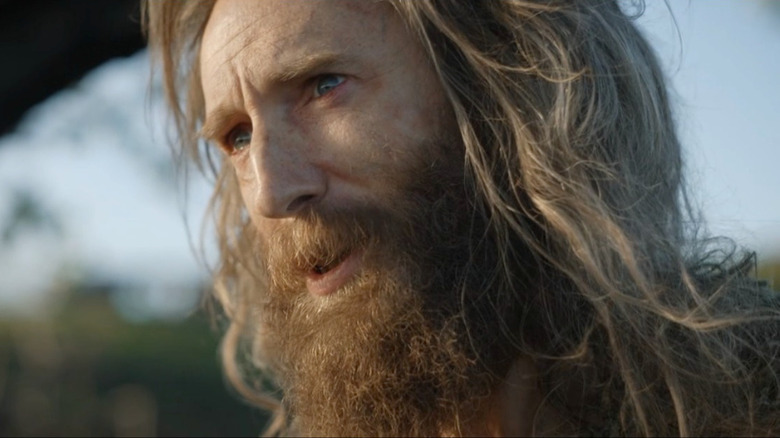Easter Eggs You Missed In The Lord Of The Rings: The Rings Of Power Season 1
Prime Video's "The Lord of the Rings: The Rings of Power" is shaping up to be a sweeping adventure across the Middle-earth landscape. Set during the Second Age, the show follows a gargantuan main cast spread out across several different kingdoms and regions of the map.
While the show is busy juggling a lot of different storylines, the production team hasn't neglected the little details. From intricate clothing to elaborate sets, everything in "Rings of Power" looks to have been handled with care. Actor Benjamin Walker (who plays Gil-galad on the series) even told Looper in an interview that he felt "gobsmacked" during his first day on set when he was greeted by an army of technicians and craftsmen and saw half-a-million hand-painted gold leaves on the ground.
The attention to detail extends beyond the quality aspect, too. Throughout the Second Age show, the talented writers' room has also managed to find a lot of opportunities to hint at the larger legendarium that Professor Tolkien created. Some of these are small details that are easy to miss. Others are legitimate Easter eggs squirreled away for eagle-eyed fans to discover on their 10th rewatch. We've scoured the footage of the first season, and here are some of the most interesting Easter eggs and small details viewers may have missed so far.
If it doesn't go without saying, what follows contains spoilers for "Lord of the Rings: The Rings of Power" Season 1.
Finrod's scratches
The Easter eggs don't take long to start popping up. In fact, there's one that appears during the show's prologue. As Galadriel can be heard narrating about her fallen brother, Finrod Felagund, we see his corpse laying on a table under a cloth. His arms are out, and his flesh is scarred with numerous wounds. The video highlights one of these cuts specifically — the mark that Sauron puts on him.
It turns out that Sauron's branding behavior isn't actually canon. In the source material, the Dark Lord doesn't go around burning a sign into people's flesh. But he does leave quite a few marks on the heroic Finrod Felagund. In "The Silmarillion," Finrod helps the heroes Beren and Lúthien in their quest to reclaim one of the titular hallowed jewels called the Silmarils. In the process, he and his companions are captured by — you guessed it — Sauron. The villain, who isn't the Dark Lord yet, kills off the group one at a time using a werewolf. Eventually, the text reads, "But when the wolf came for Beren, Felagund put forth all his power, and burst his bonds; and he wrestled with the werewolf and slew it with his hands and teeth; yet he himself was wounded to the death."
Yeah, those scratches? They aren't from a scrape in battle. They're not from swords or spears or arrows. Those are bona fide dying werewolf wounds. Talk about a way to go.
The Oath of Fëanor
Another Easter egg tucked into the early moments of "Rings of Power" appears when a bunch of tough-looking Elves draw their swords together in quick succession. For fans familiar with Tolkien's lore, the scene immediately brings to mind the famous Oath of Fëanor from "The Silmarillion." Yes, Galadriel's brother Finrod is amongst them, which is a little out of place considering the source material, but otherwise everything lines up.
The event, while skimmed over in the prologue of the show, is a watershed moment in Middle-earth history. The oath is taken by the famous Elvish character Fëanor (of all people) and his seven sons. It's an irrevocable oath that leads to a lot of terrible stuff after the fact, and it reads in the book like this: "Then Fëanor swore a terrible oath. His seven sons leapt straightway to his side and took the selfsame vow together, and red as blood shone their drawn swords in the glare of the torches."
Their swords may not be blood red in the footage. And if it's strictly the Oath of Fëanor (which, to be fair, isn't directly stated) then Finrod shouldn't be there. But the setting and actions, however briefly they're depicted, seem to be a direct nod toward the oath that is so critical to the stories that follow.
Hinting at the Battle of Unnumbered Tears and the War of Wrath
"Rings of Power" doesn't have access to "The Silmarillion," which is probably why its prologue is so quick and non-specific. It skims over many of the major events that take place in that book without clearly connecting the dots. Some are easy to spot, like the Oath of Fëanor. Others, though, seem to be a murky mash-up of multiple events presented at the same time, including a series of battles and violent conflicts. These start with a shot of a dragon throwing a giant eagle to the ground in a blaze of fire. This is an event that could have only happened during the Earth-shattering, age-ending War of Wrath right before "Rings of Power" starts. That's the battle where Morgoth, the first Dark Lord, is finally defeated.
But wait. There's more. When Galadriel picks up a helmet and puts it into a gigantic pile of other helmets, the scene calls another battle to mind. One of the most tragic events of the First Age of Middle-earth history is called the Battle of Unnumbered Tears. After the battle, which goes badly for the good guys, a giant mountain of carcasses is created called the Hill of the Slain. While it isn't quite the same thing as a bunch of helmets, the feel of Galadriel's sorrowful experience in the aftermath of the unnamed battlefield seems to hint at that famously tragic event.
Galadriel's swan boats
In Peter Jackson's extended edition of "The Fellowship of the Ring" Galadriel sails a swan boat in Lothlórien. In "Rings of Power," we see Galadriel sailing to Valinor in a boat with a similar bird-like prow. In the opening scene of the show, kid-Galadriel also makes a fantastical paper boat that doesn't just float — it sails. And as it does so, its wings, neck, and head pop up in glorious fashion.
Okay, so what's up with all of the swan boats? For the answer, we turn to Tolkien. Without going too overboard with details, one group of Elves that lives in Valinor is called the Teleri. They mostly dwell in a place called Alqualondë, which loosely translates to — drum roll, please — the Haven of the Swans. "The Silmarillion" explains this group and their home, saying, "For that was their city, and the haven of their ships; and those were made in the likeness of swans, with beaks of gold and eyes of gold and jet."
Much later in the book, it explains how the Elves visited the island nation of Númenor, too, saying, "And thence at times the Firstborn still would come sailing to Númenor in oarless boats, as white birds flying from the sunset." From the get-go, bird-shaped boats, and especially swan-shaped boats, are a trademark of Elvish maritime activity.
A gray rain curtain and a swift sunrise
When Galadriel and her company set sail for Valinor in the first episode of "Rings of Power," they arrive in a foggy, rainy sea. As the clouds roll back, it slowly reveals a glorious, blinding light, which all of the Elves but Galadriel willingly enter into. This isn't necessarily how the process of Elves leaving Middle-earth looks in the books, but there's a lot left open to interpretation here. As far as small details are concerned, though, there's one specific aspect that is worth calling out.
Twice in "The Lord of the Rings" books, Frodo experiences arriving in the Blessed Realm. The first time is in a dream in the first book. The second time is for real when he sails there at the end of "The Return of the King." Here's how that book describes the experience: "And then it seemed to him that as in his dream in the house of Bombadil, the gray rain-curtain turned all to silver glass and was rolled back, and he beheld white shores and beyond them a far green country under a swift sunrise."
We may not actually see Valinor in the scene from "Rings of Power," but we do see a gray rain curtain, and it definitely rolls back as they approach.
Are Harfoots Halflings ... or birds?
When we first meet the Harfoots in "Rings of Power," they're running circles around a couple of wary hunters. The Little People are able to lay low and avoid being seen without any issues. As the Big Folk move along, one of the Halflings blows a whistle of sorts to signal that the coast is clear.
The casual activity makes sense, but for diehard Tolkienites, it may also bring another incident to mind — a time when Théoden, King of Rohan, has a conversation with a couple of Hobbits in Isengard in "The Two Towers" book. Merry, Pippin, and Théoden all bond over the fact that their ancestors came from the same area of the world — an area close to where the Harfoots are currently living when "Rings of Power" begins.
In the discussion, Théoden mentions that the Halflings in the apocryphal stories that his ancestors remember have some interesting skill sets. He adds that they can vanish in a twinkling. In addition, he says, "They can change their voices to resemble the piping of birds." While that is clearly an exaggeration, it would appear that the "Rings of Power" writers may be hinting at how that legend came about.
Halfling children really like to eat fruit
The Harfoots of "Rings of Power" and the Hobbits of later stories may be distantly related. But there are a lot of differences that set them apart, not the least of which is the fact that one group is living a wandering, nomadic lifestyle and the other is living in undisturbed, domesticated comfort. Even so, some of the throughlines are already visible, even when the setting is so different. Case in point: their food.
Harfoots are already shown with the Hobbitish appetite for good food. Sure, the food is prepared and consumed hunter-gatherer style, but there's no denying that Harfoots still like a good meal. And when Nori leads a group of youngsters to a berry patch, their affinity for food is on full display. Interestingly, the scene also offers a cool parallel to the last pages of "The Return of the King."
In that book, Tolkien explains the happy aftermath of the War of the Ring, pointing out how much the Shire thrives after Sauron is defeated. At one point, this is illustrated through — you guessed it — kids and fruit. The text says: "The fruit was so plentiful that young hobbits very nearly bathed in strawberries and cream; and later they sat on the lawns under the plum-trees and ate, until they had made piles of stones like small pyramids or the heaped skulls of a conqueror, and then they moved on." The Harfoots will change a lot before they become Hobbits, but it looks like the kids just keep on eating fruit throughout the entire evolution.
Hinting at the shepherds of the trees?
In the first episode of "Rings of Power," there's a point when Marigold Brandyfoot has a serious talk with Nori about her downright intrepid behavior. In the talk, the Halfling mother breaks down how the world works for the younger, less experienced Nori by saying, "I've told you, countless times. Elves have forests to protect. Dwarves their mines. Men their fields of grain. Even trees have to worry about the soil beneath their roots. But we Harfoots are free from the worries of the wide world."
It's a very Hobbitish pep talk that leaves Nori squirming and doesn't even put a dent in her desire for adventure. But it also may be the first time in the series that Tolkien's Ents enter the conversation, too. The Ents are referred to at different times as the Shepherds of the Trees. They were originally created to not just to look like trees, either. They're made to protect them. In "The Silmarillion," the Ents are explicitly made as a way to guard trees against other creatures that may want to harm them. The presence of Ents in the "Rings of Power" storyline is already established later in this episode, too. They make a quick cameo when the meteor streaks overhead and three Ents are shown clearly moving amongst the trees.
Middle-earth fireworks
When Galadriel returns home from her very overextended pursuit of Sauron, the High King Gil-galad is convinced to welcome her as a hero. Despite her rebellious disregard of his orders, the king puts on a celebration to rival the likes of Bilbo's 111th birthday party. No, seriously — it even has the same kind of fireworks.
As the Elves party in Lindon, the sky lights up with fireworks that take on many different shapes. Some swirl, while others look like flowers. One even takes on the distinct shape of a butterfly ... and then flaps its wings.
In contrast, the "The Fellowship of the Ring" book describes Gandalf's fireworks at Bilbo's party by saying they included singing bird sounds, trees losing their leaves, eagles, sailing ships, and much more. It also has the line, "There were fountains of butterflies that flew glittering into the trees." Sound familiar? Of course, the question of who's better at the craft of making fireworks is something that would have to be solved with a head-to-head contest between the wizard and the Elves. But alas, it's a competition we'll never get to see.
Important statues
After Galadriel discovers that she's going to be shipped back home to Valinor in Episode 1, she retreats to a peaceful area of the Lindon forests where Elrond finds her, and the two characters proceed to have a long talk. As they chat, they're surrounded by a string of very Elvish-looking lamps and a series of statues carved right into living trees.
One of these statues depicts Galadriel's brother Finrod, who is an epic First Age hero in his own right, but several others appear as well. We're willing to guess that at least one is the Human First Age hero Túrin Turambar. There are plenty of candidates for who the others could be, but there's one statue whose identity is without question.
At one point, the camera flashes past a living wooden statue of a woman with long, flowing hair and a shaggy dog in front of her. There's no doubt that this is an image of the immortal maiden Lúthien and the dog Huan. Lúthien is one of the iconic heroines of Tolkien's legendarium; she was inspired by the author's wife and her Elvish name was even put on her gravestone. She's known for her hair and also happens to be Elrond's great grandmother. The dog, Huan, is also the greatest woflhound in Middle-earth history. He talks multiple times and even defeats Sauron in a duel at one point.
A childish Stranger
When The Stranger crash lands near the Harfoots, Nori and Poppy try to take care of him. This ends up being more difficult than it seems at first glance due to the fact that the fellow initially acts like a child. He can't even talk and doesn't know how to take care of himself.
For those who know their Tolkien, this seems to point very heavily toward The Stranger being a Wizard. Apart from the fact that he's clearly supernaturally powerful, the whole infantile start to his Middle-earth tenure points to his Wizarding origins.
In the book "Unfinished Tales," Tolkien's son Christopher brought together most of his father's notes about the Wizards or "Istari" as they're called in Elvish. In that collection of random facts, it says, "For it is said in deed that being embodied the Istari had need to learn much anew by slow experience, and though they knew whence they came the memory of the Blessed Realm was to them a vision from afar off, for which (so long as they remained true to their mission) they yearned exceedingly."
If The Stranger is a Wizard, it would make sense that after his arrival, he would need to relearn some basic things, like talking and eating. Add onto that the fact that he clearly knows some stuff, like constellations, and we must ask ourselves, who is The Stranger from "Rings of Power?"
The Stranger whispers to animals
As Nori and Poppy wrangle their mysterious, powerful friend, they slowly start to get some clues about who he is. Particularly toward the end of the second episode, he manages to communicate by using fireflies to form the shape of a constellation in the sky. Nori gets excited when she realizes that he wants to find a similar shape of actual stars.
During this scene, there's also a small Easter egg that points back to Peter Jackson's films. When Ian McKellen's Gandalf is trapped on top of Isengard, he catches a moth and whispers a message to it in an unintelligible language. The Stranger talks to the fireflies in a very similar manner in the second episode of "Rings of Power." This could signal a direct connection between the characters — for instance, maybe they're both Gandalf?
It could also simply be a magical behavior that they're both displaying. This could be meant to showcase how both characters are Wizards, or at least have a similar spiritual power that enables them to talk directly to animals. Whatever the answer, the way The Stranger chats up the fireflies looks so similar to Gandalf's discussion with the moth, it's difficult to think it's anything less than a direct Easter egg.
Fëanor's hammer ... and family tree
When Elrond arrives in Eregion in the second episode of "Rings of Power," he hits things off with Lord Celebrimbor, whose craftsmanship he's greatly admired from afar. As they get to know one another, they talk about a crafting hammer on display in Celebrimbor's workshop. And it's not just any hammer. It used to belong to the master Elven craftsman Fëanor. While the show makes that fact clear, the quiet context left out of the dialogue is Celebrimbor probably has the hammer because he's Fëanor's grandson.
The little details don't stop there, either. As the conversation carries on, the two Elves look at plans to build a giant, overheated new addition to Celebrimbor's workshop. The Elven master craftsman says that he wants to build "A tower. One that could host a forge more powerful than any ever built. Able to birth a flame as hot as a dragon's tongue and as pure as starlight."
The subtle reference brings to mind a line from "The Fellowship of the Ring" book where Gandalf says, "It has been said that dragon-fire could melt and consume the Rings of Power, but there is not now any dragon left on earth in which the old fire is hot enough." The reference to a forge as hot as a dragon's tongue is a fitting description because, chances are, Celebrimbor has plans to use his new forge to create some tiny little ring-shaped trinkets in the not-too-distant future.
Khazad-dûm has some delicious food
When Elrond and Celebrimbor head over to Khazad-dûm to recruit the help of the Dwarves, the Lord of Eregion informs his companion that he's always admired the Dwarves and wonders if he'll be able to see them at work in their forges up close and personal. Elrond sets some rather lofty expectations in response, pointing out that he thinks they'll do a lot more than that. From there, he launches into a description of Dwarven hospitality that includes blaring Ram's horns, tables full of salted pork, and lots and lots of malt beer.
If the depiction sounds familiar, it's because Gimli talks about the same kind of Dwarven welcome thousands of years later during "The Lord of the Rings." In "The Fellowship of the Ring" movie, as Frodo and company enter Moria, Gimli warns Legolas to prepare for the fabled hospitality of the Dwarves, adding that the Master Elf should expect "roaring fires, malt beer, ripe meat off the bone." Later on, in "The Return of the King" movie, Pippin also references salted pork to Gimli's interest and great delight.
Tying these references to Dwarves is a fun way to create some continuity between the two distinctly different versions of Middle-earth. Both may be their own adaptations that march to the beat of their own drums. But when it comes to Dwarven hospitality, everyone's on the same page.
Dwarves, their masks, and their maker
The Dwarves have an interesting creation story. Unlike Men and Elves who are created by the God-like supreme being Eru Ilúvatar, Dwarves are initially formed by the angelic being Aulë. While he makes them, though, Aulë can't give his Dwarves sentient life. That's something that only Ilúvatar can do, and he eventually gets around to it. Even so, the Dwarves always have a special affinity for Aulë, and it shows in "Rings of Power."
In the rock-breaking scene, Durin IV references his semi-maker when he describes the event as "The Dwarven test of endurance fashioned by Aulë himself." Later on, when Durin and Elrond are arguing, Disa expresses her disapproval by referencing Aulë's beard. For most viewers, it's a random and odd name. For Tolkien fans, it's a clear and well-placed reference to the greatest being in all of Dwarven culture and history.
It's also worth pointing out that the full Dwarven face masks worn by many of the guards of Khazad-dûm get their inspiration from "The Silmarillion." At one point, the Dwarves take on a bunch of dragons, which they can do because, "It was their custom moreover to wear great masks in battle hideous to look upon; and those stood them in good stead against the dragons." It's a one-off reference, and it's fun to see the famous head gear translated into the garb of Durin's guards.
Badly ending Elven-Human love affairs
When we first meet Arondir in the Southlands of Middle-earth, he's visiting a town of Men with a fellow Elven warden. While there, he interacts with the Human woman Bronwyn and it's clear that the two are crushing on one another. As they leave, Arondir and his fellow Elf verbally spar back and forth, like any good pair of soldiers would do. Eventually, though, the talk turns more serious, and Arondir's companion says, "My point is this. Only twice in known history has a pairing between Elves and Humans even been attempted. And on each occasion, it ended in tragedy. It ended in death."
The reference is to two distinct pairings. The first is the mortal man Beren and the immortal Lúthien. They get hitched and end up dying ... twice. Kind of. It's complicated. The other pair is the Man Tuor and the Elf-maiden Idril. While they have a happier ending, there's no doubt that their tale is filled with some epic and tragic stuff.
Love affairs between Elves and Humans are never common in Tolkien's writings. In fact, it's a topic that Looper discussed with Arondir and Bronwyn actors Ismael Cruz Córdova and Nazanin Boniadi, respectively. Wherever they choose to go with their characters' romance, though, it's cool that the writers used the opportunity to indirectly reference two of the most important mortal-immortal couplings in all of Tolkien's writings.
The beacons are lit!
Anyone who's watched Peter Jackson's "The Lord of the Rings" trilogy is familiar with the epic scene in "The Return of the King" when Pippin lights the beacons of Gondor. The little Halfling scales a watchtower and tosses a flame onto a pile of brushwood without the guards seeing him. This sets off a string of similar fire-bound watchtowers, which send a visual message to King Théoden in Rohan that Gondor calls for aid. The scene is also mirrored in the opening chapter of "The Return of the King" book, although in this case, Pippin observes the lit beacons from afar rather than lighting them himself.
In either case, the opportunity to light some beacons (and show off some gorgeous Middle-earth landscapes in the process) is too good to miss. and it should come as no surprise that "The Rings of Power" found its own way to sneak some lit beacons into its own adaptation. In Episode 3, when Galadriel and Halbrand arrive in Númenor on Elendil's ship, they pass a watchtower out at sea. As they look up, lo and behold, a beacon is burning. In this case, it's likely a lighthouse beacon designed for ships, but the callback to Peter Jackson's films is difficult to miss.
Special statues in Númenor
The Elves aren't the only ones with special statues. While Lindon is littered with gorgeous wooden carvings, Númenor has a lot of its own sculptures, mostly chiseled right into stone. In Episode 3, as Elendil's ship sails down the narrow waterway that leads into the heart of his home island, viewers can see giant statues of heads perched along the route. Full-blown forms are also shown, including a gigantic statue just as the ship arrives in the main port.
This last statue was a central point of speculation for months after it first showed up in the show's original Super Bowl ad in early 2022. Guesses as to the statue's identity spanned the gamut (Númenor has a lot of kings and queens) but there are a couple of details that make one guess the clear frontrunner. First, there's a giant statue of a bird next to the humanoid figure. Second, if you look really closely, there appears to be a small item bound to its forehead.
This indicates that we're looking at a statue of Eärendil, one of Tolkien's most important Middle-earth heroes. His wife is Elwing, who — get this — is turned into a bird at one point. He's also the father of Elrond and his twin brother Elros, who is the first king of Númenor. And the thing on his forehead? Eärendil ends up sailing through the heavens on his ship with one of the shining jewels called the Silmarils tied up there. Oh yeah. It's all coming together.
Blowing in horns ... made of shells
When Isildur first shows up, it's early in Episode 3 when we see the young cadet preparing for the sea trials with his shipmates. When the exercise is completed, they sail to shore and stand, facing the water, while the drill sergeant blows on a horn and says "The sea is always right" — a phrase that's repeated by the cadets. Once the ceremony is over, everyone goes home. Okay, so what's the big deal?
The Easter egg here is tucked into the drill sergeant's accouterments — specifically, his shell-shaped musical instrument. The choice of a shell isn't just a fun way to show off the Númenórean penchant for sea travel. It's a detail that connects right back to one of the most important beings in all of Middle-earth: Ulmo.
Ulmo is one of the Valar, the angelic beings who function as the lowercase "g" gods and guardians of Middle-earth. Ulmo is called the Lord of Waters, and his power extends throughout all of the oceans, seas, and tributaries of the world. And what does a being as epic as Ulmo, the Lord of Waters use to get some attention? Why giant sea shells, of course. No, for real. "The Silmarillion" says that, at times, Ulmo will come to Middle-earth and "there make music upon his great horns, the Ulumúri, that are wrought of white shell; and those to whom that music comes hear it ever after in their hearts, and longing for the sea never leaves them again."
White trees galore
When we arrive in Númenor in Episode 3, there are a lot of sights to take in all at once. One of these is a stunningly vibrant tree with white petals. This isn't the first time we've seen this tree, either. It's shown up repeatedly in the marketing, as well — including shots of the petals floating in the wind far from the tree itself (an omen of decay, perhaps?).
The concept of a white tree isn't new to Tolkien fans — even casual viewers of the films. In Peter Jackson's "The Return of the King" movie, a white tree can be seen in the center of a court in Minas Tirith, except this time, we're looking at a dead corpse, not a thriving, living organism. The two images aren't just similar, either. They're actually related.
That's right, the dead White Tree of Gondor can trace its roots back to its ancestor seen in Númenor in "The Rings of Power." The Númenórean iteration of the arboreal wonder is called Nimloth, and it's brought to Númenor by the Elves as a gift from Valinor — in fact, its lineage goes even further back than that, but we have to cut this explanation off somewhere. Eventually, Isildur takes a fruit of Nimloth with him to Middle-earth, where he plants it in Minas Ithil. When that fortress is captured and becomes the headquarters of the Nazgûl, the tree is destroyed, but one of its fruits survives and is planted in, you guessed it, Minas Tirith.
You bow to no one
One of the most iconic moments in all of Peter Jackson's films takes place when the four heroic Hobbits, Frodo, Sam, Merry, and Pippin, come before the seat of the newly crowned king, Aragorn. When they go to bow down, Strider stops them, telling them that they bow to no one. It's a spine-tingling acknowledgment of the incredible deeds that the quartet of Halflings just accomplished ... and it's another line that is quietly reflected in "The Rings of Power."
When Galadriel and Halbrand are brought in front of Queen Regent Míriel, Halbrand is doing his best to help his Elvish companion keep up with the manners of Men. When they're standing in front of the queen, he whispers to Galadriel to kneel, only to have Míriel stop them by saying, "No one kneels in Númenor." The little royal custom is a fun way to set the tone for a kingdom of Men where everyone is blessed. But it's also a great way to sneak in a little reminder that, even thousands of years later, Númenórean kings are still able to acknowledge greatness when they see it.
Míriel's grandfather's great-grandfather rejects the Elves?
In "The Rings of Power," Númenor is led by Queen Regent Míriel when Galadriel and Halbrand first arrive. In Episode 3, Míriel talks to Elendil about the struggle that her people have with trusting Elves. She points out that "Elves have been unwelcome on our shores since the reign of my grandfather's great-grandfather." This feels like an eloquently written throwaway line meant to emphasize how serious it is that Elendil brought an Elf back to Númenor, but as with all things Tolkien, things go much deeper than that.
The author traced the entire line of Númenórean kings in his writings, which means we can take a quick stroll back up the family tree to see who Míriel's "grandfather's great-grandfather is," and it turns out that it's a not-so-nice fellow named Ar-Adûnakhôr. In the book "Unfinished Tales," Tolkien explains that "In this reign the Elven-tongues were no longer used, nor permitted to be taught, but were maintained in secret by the Faithful; and the ships from Eressëa came seldom and secretly to the west shores of Númenor thereafter." (Eressëa is a the name for an Elven area in the West.)
So yeah, when Míriel specifically highlights that her — let's see if we can get this right — great-great-great grandfather started the antipathy toward the Elves, it isn't a line that the writers created out of whole cloth. It's a deliberate reference to a grumpy Númenórean king who ruled long before the "Rings of Power" story ever starts.
I know his brother better
When Galadriel visits the Western regions of Númenor with Elendil, the pair of travelers visit the Hall of Lore, a library and depository of information that Elros, the first king of Númenor, himself created. While the actual hall is made up for the show, Elros is very much a Tolkien original — he's the brother of Elrond and a character that comes from a very complicated family tree that includes Elves, Men, and even the angelic Maiar. While Elrond chooses the immortal life of an Elf, though, Elros opts for the mortality of being a Man. Along with choosing the mystery of the gift of death, Elros also becomes a mighty king who founds Númenor and lives for five centuries.
Even so, by the time of "The Rings of Power," Elros has been gone for a long while ... even though his twin brother is still serving as Gil-galad's Herald back in Lindon. This leads to an interesting line when Galadriel and Elendil look at a tapestry of the twin brothers in the Hall of Lore. Galadriel confirms that she knew Elros, adding, "But I was always closer with his brother." For savvy viewers, this is a quiet connection to Galadriel's already established friendship with Elrond (as shown in Episode 1). But it goes even deeper: In the source material, Elrond will eventually marry Galadriel's daughter, and the two will go on to serve on the White Council and generally resist Sauron side by side over the millennia. To say she's closer to Elrond is an understatement.
Beings turned into stars
Early in Season 1, the Harfoot leader Sadoc Burrows tells an endlessly inquisitive Nori Brandyfoot that the stars are strange. The foreboding words literally materialize in the form of the Stranger, who crash lands from the sky right near the Halfling community. Nori takes the Stranger under her tiny yet formidable wing and, in Episode 3, it comes out that she's been helping the odd super-powered giant.
In the fallout, Sadoc faces off against Nori, inquisitor style, reprimanding her in front of the entire clan. At one point, Nori's father Largo chimes in, pointing out that the whole situation is extraordinary before asking "Have you ever heard tell of beings falling from the stars?" Sadoc's response: "I've heard of beings that were turned into stars, but never the other way around."
The reference to beings becoming stars feels random, but once again, it could be a quiet Easter egg pointing to Tolkien's famous sailor of the firmament, Eärendil. The hero ends his epic First Age career by having a shining Silmaril bound to his forehead before his ship sails off into the heavens over Middle-earth — in effect, turning him into a star. The thought that a random Harfoot leader in an isolated community would somehow know about Eärendil seems unlikely, but the line could still be left behind for those to find it who can.
Nori knows she isn't special
The last time we see Nori in Episode 3, her mother, Marigold, confronts her about her actions with the Stranger, asking if she thinks it's destiny and that she's somehow special. The little Harfoot's response is, "I know I'm not special. I know I'm just one little Harfoot in a grand, wide world." For fans of Tolkien's legendarium, the line echoes another spoken by Gandalf at the end of "The Hobbit."
On the last page of that book, Gandalf and some of the Dwarves come back to visit their burglar bestie in the Shire. Bilbo expresses surprise that so many things they hoped to happen had come true, at which point the Grey Wizard interjects, "And why should not they prove true? Surely you don't disbelieve the prophesies, because you had a hand in bringing them about yourself?"
Gandalf goes on to highlight the larger purpose behind Bilbo's story, saying, "You don't really suppose, do you, that all your adventures and escapes were managed by mere luck, just for your sole benefit? You are a very fine person, Mr. Baggins, and I am very fond of you; but you are only quite a little fellow in a wide world, after all." This concept of a higher purpose runs throughout Tolkien's stories, and it's cool to see the larger theme reflected in Nori's small-yet-significant story.
Is that a Maia we spy?
When Galadriel visits Halbrand in prison, the center of the room is filled with a giant statue of a blue, mermaid-looking female figure positioned as if she's swimming. It's an odd sight in the midst of a jail, but it may be there to help calm the occupants in their cells. Why? Because it looks an awful lot like the Maia Uinen, an angelic being known for bringing peace and calm to turbulent waters.
Uinen is married to the violent Maia Ossë, who has a reputation for causing storms at sea. "The Silmarillion" describes Uinen as the counterpoint to her spouse, adding "[Ossë's] spouse is Uinen, the Lady of the Seas, whose hair lies spread through all waters under sky. All creatures she loves that live in the salt streams, and all weeds that grow there; to her mariners cry, for she can lay calm upon the waves, restraining the wildness of Ossë."
The flattering description ends with the line "The Númenóreans lived long in her protection, and held her in reverence equal to the Valar." While it could just be a random statue, the fact that she's loved by the Men of Númenor and even details like the seaweed in her hair seem to reinforce the idea that we're looking at an Easter egg visualization of the Lady of the Seas.
Stuck in a cage
In Episode 3, it's revealed that Halbrand's mysterious past has something to do with a royal connection to the Southlands. This immediately gives the character a "returning king" feel similar to that of Aragorn thousands of years later. Of course, the news that his ancestors fought for the Dark Lord Morgoth is still a major factor here, but still, Halbrand has the growing potential to play a critical role in the story.
Of course, when this information is revealed, the character is still behind bars — and he points that out to Galadriel, saying "It's an odd thing to say to a man in a cage." The use of the word "cage" is interesting here, as it immediately harkens back to Éowyn. In the "Return of the King" book, Aragorn asks the Shield-maiden what she fears, to which Éowyn responds, "A cage," adding, "To stay behind bars, until use and old age accept them, and all chance of doing great deeds is gone beyond recall or desire."
The circumstances and motivation may be quite different. Nevertheless, the image of an individual trapped in a metaphorical "cage" is one that is certainly familiar to fans of Tolkien's world.
Elendil is a petty lord
When we first meet Elendil in "The Rings of Power," he's a ship captain. As far as we can see, he has a limited amount of authority as a military man, and that's about it. Then, Pharazôn casually mentions to his Queen Regent that the man comes from a noble line. Okay, so there's more here than we were initially aware of. In the fourth episode, "The Great Wave," as Galadriel and Míriel verbally spar about Halbrand's claim to the throne of the Southlands, Elendil adds to this growing pedigree by mentioning that he's a "petty lord."
For fans of Tolkien's writings, this immediately brings to mind the title of the "Lords of Adúnië." This is an offshoot of the royal line that rules in the western region of Númenor, facing Valinor. In Tolkien's original writings, the Lords of Adúnië were important people in the Númenórean political system. They were also leaders of the Faithful, who preserved the Elven ways of ancient Númenor.
The last Lord of Adúnië was a fellow named Amandil. His son never got the chance to become his heir because of some spoilery stuff that we won't break down here. But let's just say that Amandil's son was a guy named Elendil. Yep, that Elendil.
Isildur's friends have interesting names
In Episode 3, one of Isildur's fellow cadets on his ship lets a rope slip. The hero catches the loose line and hauls his shipmate back to safety, but the friend is dismissed from the sea guard for his mistake. This individual, who is made up for the show, is named Imrahil, which happens to be the name of one of the most famous captains of Gondor in the "Lord of the Rings" story. Coincidence? We think not.
On top of that, one of Isildur's close friends is named Valandil. Again, the character is made up for the "Rings of Power" story, but the name choice seems deliberate, as Valandil is a name that shows up more than once in Tolkien's legendarium. It's the cognomen of one of Isildur's ancient ancestors, the first Lord of Adúnië. In a very early version of the legendarium, it's also the name of Isildur's uncle. In fact, this is so early on that in this iteration, uncle Val is functioning in Isildur's role as the guy who founds Gondor later on in history. As if that wasn't enough, Valandil is also the name of one of Isildur's sons and his future heir. That means, it's the name of an ancestor, an uncle, a son ... and now a friend.
The mouth of the river
When Arondir meets Adar, the villain talks to him in a surprisingly relatable way. He asks him where he was born, and when Arondir replies "Beleriand," Adar asks the follow-up question, "By the mouth of the river?" The conversation moves on from there, leaving the mysterious body of water unnamed. But the wording gives us a clue about which area could be in question.
Beleriand is the name for the westernmost portion of Middle-earth. It's a huge area of land where most of the events of the First Age take place. However, Beleriand isn't a factor after that point because, when that era ends, the entire chunk of the continent is drowned beneath the waves.
Beleriand has a lot of very famous geographic locations — including several important rivers. One of these, and arguably the most important, is the River Sirion. It's so big that it stretches across a huge portion of the continent. And when it reaches the ocean, it splits into a large delta called — drum roll, please — the Mouths of Sirion.
A lot of important things happen here, too. It's particularly important as a refuge and a central point where most of the world-shaking events of the end of the age take place. When Adar refers to "the mouth of the river," there's a good chance that this is what he's talking about.
The rocks and roots remember them
When Arondir asks Adar why the Orcs call him father, he replies "You have been told many lies. Some run so deep even the rocks and roots now believe them. To untangle it all would all but require the creation of a new world." This reference to roots and even rocks understanding things has shown up in Middle-earth before in reference to another area of "The Rings of Power" story.
In "The Fellowship of the Ring," right before they reach Moria, Frodo and company pass through the region that used to be the Elvish realm of Eregion — that's the area led by Celebrimbor in "The Rings of Power." By the time of "The Lord of the Rings," this area is desolate, and the Elves are long gone, leading Legolas to say "the trees and the grass do not now remember them. Only I hear the stones lament them: Deep they delved us, fair they wrought us, high they builded us; but they are gone. They are gone. They sought the Havens long ago."
Tolkien's Elves are closely connected to the world. So, while Men, Dwarves, and Hobbits might blunder along, making a noise like elephants, Elves are always aware of how their actions impact their surroundings. Whether it's Legolas listening to the rocks of Eregion or Adar trying to rewrite a history deeply embedded in the very fabric of the world itself, you can bet they're hearing more than our mortal ears are picking up.
Casually mentioning Orodruin
We may know it as Mount Doom in "The Lord of the Rings," but another name for Sauron's personal forge-mountain is Orodruin. It's an Elvish name that, in "The Silmarillion," is translated as "Mountain of Blazing Fire." Seems appropriate enough. The peak is stealthily introduced in the background of a few shots early in the series, but it isn't until Episode 4 that we hear it directly mentioned.
In that episode, as the Southlanders seek protection in a nearby watchtower, Bronwyn looks at the column of individuals who are arriving and notices how many different people are pouring into the fortress. This leads her to state, "That makes it every village from here to Orodruin."
The line is focused on the severity of the situation, and Bronwyn's face is clearly worried as she tries to manage the endless line of refugees. The fact that she doesn't say "Mount Doom" also makes it easy to miss. And yet there it is. Orodruin is a regular fixture of their Southland life and one that is casually mentioned in conversation — even if it's quietly harboring the potential to ruin that very existence if it blows its top. The question is, if Orodruin means "Mountain of Blazing Fire," why is it called that already? In "The Silmarillion," it says that the Elves are the ones who give it that name. Were they around early enough to see its fiery potential in the past? Or is this just a nominal oversight?
Licking blood
In Episode 4, when Theo sneaks back to town to forage for some food, he goes into a tavern where he's attacked by an Orc. The vicious assailant hacks at the boy, initially cutting through the grain sack he's holding and then catching his leg on the second swipe. We then get a close-up of the Orc licking the blood off of his knife in a threatening manner.
The visual immediately invokes the scene in Peter Jackson's trilogy when the towering Uruk-hai Lurtz is stabbed by Aragorn in the leg. The cold-blooded warrior pulls the blade out of his own flesh and then licks it, clearly as an intimidation tactic before he hurls it right back at Aragorn's face. Of course, in this case, it's his own blood that he's licking, which is particularly gross. In "The Rings of Power," at least the Orc is getting some Human blood — which is a dietary option that they actually like. Looks like meat's back on the menu, boys.
Meeting Elrond's father
Episode 4 tackles the question of Elrond's parentage more than once. The first time it comes up, it's when the Herald is with Celebrimbor, who mentions that he looks just like his father. Elrond replies inquisitively, clearly surprised that Celebrimbor had ever met his pops, to which the Elven Lord replies, "Of course, many times."
This is a veiled reference to a backstory that even Tolkien never fully fleshed out. The early life of Celebrimbor is underdeveloped, to say the least. Chances are, though, that he spent a decent amount of time in the famous Elven stronghold of Gondolin — where Elrond's father, Eärendil, was born. Eärendil is less than ten years old when that city is destroyed, though, and after that, we have no idea whether he and Celebrimbor cross paths again. It's a couple of loose ends that "The Rings of Power" showrunners JD Payne and Patrick McKay have chosen to connect via a backstory in their own narrative that clearly has Eärendil and Celebrimbor connecting more than once in their early lives.
Guarding three doors
In Episode 4, Elrond visits Khazad-dûm to get to the bottom of why Durin IV is avoiding him and Celebrimbor. When he reaches his Dwarven friend's house, though, Durin isn't home, and Disa gives a few reasons that could be the case before she suddenly remembers that "He was off to mine Quartz Chasm today." Elrond immediately reads into the deception, and the two continue to dance around the truth for the rest of the conversation.
When Disa is listing off places where Durin could be, though, she casually asks if Elrond has tried "The three-door guard." While there are doubtless many areas of Khazad-dûm with more than one door, this has to be a reference to one place in particular.
When "The Fellowship of the Ring" passes through Moria thousands of years later, Gandalf confidently guides them on each step of the journey in the dark ... until they reach a particularly troubling impasse that the wizard can't remember. The location in question? A point where the path splits into three different passages. It's enough of a conundrum that they have to stop and give Gandalf time to think. When they do that, in the book version, they take refuge in a nearby guard house, which prompts Gimli to say, "This seems to have been a guardroom, made for the watching of the three passages." Could this be the "three-door guard" referenced in "The Rings of Power"? Seems likely to us.
Super-powered vision ... and the Mirrormere
When Elrond can't figure out what's going on with Prince Durin by talking directly to his wife, he resorts to straight-up spying on the couple from a distance. He's able to do this from far away due to the power of his Elf eyes, which can see much clearer than those of other mortal races. Through his espionage, the Half-elven herald realizes that Durin is working on a special project in "the old mine below the Mirrormere."
And what is the Mirrormere? We're glad you asked. This isn't an object inside of Khazad-dûm, but rather an important lake just outside of its eastern gate. The Mirrormere is a body of water that Durin IV's ancestor, Durin I, discovers very early in Middle-earth history right before he decides to found Khazad-dûm in the nearby mountains. Gimli chants about it in the "Fellowship of the Ring" book, and it's a very important part of Dwarvish culture — especially for the Longbeard clan that lives in the mines.
The curious question here is if the mine really is below the actual Mirrormere lake. The body of water is all the way on the far side of the Misty Mountains, about as far away from the entrance Elrond uses to get into the Dwarf mansion as you can get. It's not an easy journey, but he's got time. Maybe he thought he needed the exercise, too.
Fighting a sea monster
When Isildur and Eärien meet up late in Episode 4, the former tells his sister that he and his friends have been booted from the sea guard. As the siblings talk, a massive mural can be seen behind them. It appears to show a ship full of sailors fighting an enormous sea serpent of sorts. It's a site that is very familiar after the second episode of Season 1, where a massive monster attacks the raft with Halbrand and Galadriel.
The Easter egg here isn't about the monster, though. It has to do with the sailors: Most of them are hairy-looking Men with full beards and heads of thick hair, but one of the figures is clearly an Elf in fancy armor with long, blond hair and pointy ears. Whether this points to a specific event that we'll eventually hear about is unclear, but the presence of Elves in a Númenorórean mural is interesting. At this point, it's the kind of thing that you would only expect to see in Isildur and Eärien's Elf-friendly homeland in the West. This is an area where Elves used to visit regularly, bringing gifts, making friends ... and apparently in the world of "The Rings of Power," helping the local Men take down a sea beast every once in a while, too.
Galadriel's proto-mirror
In Episode 4, Queen Regent Míriel finally starts to make some headway in her relationship with Galadriel when she brings the headstrong Elf to take a look-see at her palantir. The royal warns her Elven visitor that, in spite of her past experience using seeing stones, this one is very different, since it's fixed on a specific vision — one of a Great Wave destroying the island kingdom. When Galadriel sees for herself, she's quick to calm Míriel's fears by saying that palantíri show many visions, adding that "Some that will never come to pass."
It's a line that the future Lady of Lorien clearly takes to heart because she says something very similar thousands of years later. In the "Fellowship of the Ring" book, when Galadriel explains her far-seeing mirror to Sam, she says "Remember that the Mirror shows many things, and not all have yet come to pass. Some never come to be, unless those that behold the visions turn aside from their path to prevent them. The Mirror is dangerous as a guide of deeds." It would appear that, at least in the "Rings of Power" adaptation, Galadriel starts to accumulate this sage wisdom all the way back in the Second Age as she sorts through what to do about visions of Númenor's destruction.
A Wizard learns to talk
The further into Season 1 you go, the more clear it is that the Stranger is a Wizard. The mystical fellow is clearly otherworldly, since he, you know, fell from the sky. He also displays magical powers on a regular basis. But there's another obscure element that points to his being one of Tolkien's grey-bearded order of the Istari (Elvish for Wizards): his need to relearn things.
Episode 5, "Partings," opens with Nori Brandyfoot having a broken conversation with the Stranger. The two have been traveling for a while now, and the oversized Harfoot traveling companion has had a chance to figure out how to communicate a bit. As he learns to express himself, it becomes clear that he's not entirely a blank slate. Sure, he's figuring basic things out again, but he has some memories and is slowly piecing things together.
This harkens to a section of the book "Unfinished Tales," where it says, "For it is said indeed that being embodied the Istari had need to learn much anew by slow experience, and though they knew whence they came the memory of the Blessed Realm was to them a vision from afar off, for which (so long as they remained true to their mission) they yearned exceedingly." It's a small-yet-critical detail that points to the fact that this guy is a straight-up, bona fide Middle-earth Wizard. Maybe that constellation he's searching for is even a yearning he has toward a view of the heavens from the Blessed Realm. The question is, which Wizard is he?
Visiting the marshes
Early in Episode 5, we get a quick montage of the Harfoots on the move. The map shows them passing places called, among other things, Thistledell, The Braids, Trout Bend, and Weedbrook. Two spots stand out more than the rest, though — a pair of names next to each other on a very recognizable part of the map called Undercliffs and the Grey Marshes.
The first is an area that is eventually known as the Emyn Muil, and it's the strip of treacherously hilly country that Frodo and Sam cross right before they meet Gollum thousands of years later. The Grey Marshes right next to them eventually become known as the Nindalf, a swampy region near the flat area that is later called the Dead Marshes. That's the haunted quagmire that Frodo and Sam fall into while following Gollum toward the Black Gates of Mordor. The region isn't haunted when the Harfoots pass through, though. Not yet. That comes later in the "Rings of Power" story.
Finally, who can resist a good Peter Jackson callback? As the map fades, we're shown the Brandyfoots, Poppy, and the Stranger as they work their way through the marshes. We see them plagued by flying insects that are immediately reminiscent of "The Fellowship of the Ring" where four Hobbits follow Strider through the fly-infested swamp called the Midgwater Marshes. The only question we have is, "What do they eat when they can't get Harfoot?"
Not all who wander are lost
As the Harfoots travel during the beginning of Episode 5, Poppy Proudfellow sings her parents' walking song to keep everyone in good spirits on the long road ahead. One of the lines in the song says "that not all who wonder or wander are lost" — a string of words that are clearly inspired by a similar line in a poem from "The Lord of the Rings."
When Frodo and company get to Bree in the "Fellowship of the Ring" book, they receive a letter from Gandalf. In that letter, the Wizard records a poem that they can use to vet any strangers they meet and make sure that they're actually Aragorn son of Arathorn, and not an imposter. The first two lines of that poem read — drum roll, please — "All that is gold does not glitter, not all those who wander are lost." The concept of purposeful wandering is one that is found often in Tolkien's writings. It's also something that applies to the Harfoot way of life very well, and it's fun to see the writers of "The Rings of Power" finding clever ways like this to weave Tolkien's original writings into their Second Age show.
What kind of wolf is that?
Early in Episode 5, the Harfoots are attacked by a pack of wolves while they're on the road. The assault is stymied when the Stranger intervenes with some unexpected magic, sending the four-legged beasts scampering for cover. While the show has referred to the animals as wolves, it doesn't take much to see that they're not your traditional canine. These creatures have huge upper bodies, oddly shaped snouts, and almost hoof-like paws — and we're willing to bet that's for a reason.
"The Silmarillion" explains that, early in the Second Age, "Men dwelt in darkness and were troubled by many evil things that Morgoth had devised in the days of his dominion: demons, and dragons, and misshapen beasts, and the unclean Orcs that are mockeries of the Children of Ilúvatar." That mention of misshapen beasts is left vague and unclear. Could it be that these animals aren't just wolves but a form of the warped and twisted creatures mentioned in Tolkien's original text?
An Elf-warrior with a pure heart
In Episode 5, Elrond recounts an apocryphal tale of the origin of mithril. The story starts with two individuals dueling on a mountain top over a tree with one of the hallowed jewels called the Silmarils inside of it. On the right, we have a Balrog of Morgoth wielding a whip of flame. And on the left? An Elf-warrior. But not just any Elven hero. Elrond says it's "An Elven warrior with a heart as pure as Manwë." One quick follow-up: who's Manwë?
Manwë, or Manwë Súlimo if you're being formal, is basically the head honcho of the group of immortal beings called the Valar. These are referred to at different times as angelic beings or lower-case "g" gods. Either way, they're the spiritual leaders of Arda, and Tolkien himself refers to them as the guardians of the world. There are 14 Valar total and countless other Maiar (similar angelic beings without the titular status of a Valar), and Manwë is considered their king, along with Varda, his wife and queen. Manwë is associated with wind, Eagles, and all of the sky and air-related stuff. He's also considered extremely pure and "The Silmarillion" summarizes this by saying, "Manwë is dearest to Ilúvatar and understands most clearly his purposes." (Ilúvatar is the Creator of all.) So, yeah, putting an Elf on the same tier as Manwë isn't a light comparison. No wonder mithril came out of the deal.
Mentioning Stone-giants
When Galadriel visits Elendil as he trains raw Númenórean recruits in Episode 5, she looks on the soldiers' swordplay and casually mentions that "Their strokes fall like the Stone-giants of the North Moors." The disparaging remark leads to a dramatic display of Galadriel's centuries-old experience as a warrior and swordsman — sword-elf? Sword-she-elf? Anyway, it's easy to forget the remark in the dazzling fencing that follows.
But, hold the phone for a second. Did she say giants? That's no mere mention, even for an immortal Elf who's seen some stuff. Why? Because the truth is, giants are barely involved in Tolkien's world. In fact, they're only mentioned on rare occasions, and only really show up once in legitimate Middle-earth stories.
In "The Hobbit," Bilbo, Gandalf, and the Dwarves head into the Misty Mountains after leaving Rivendell, and they quickly encounter not just a thunderstorm, but a thunder battle. During the violent weather engagement, the book tells us that Bilbo "peeped out in the lightning-flashes" and "saw that across the valley the Stone-giants were out." It goes on to explain the giant creatures' raucous behavior, and that's it. We never really hear of giants again, other than in obscure and unreliable references. For Galadriel to mention them means she's seen some things in her days — or at least heard some stories that she's adopted into her vernacular.
Talking in Elvish code
When Galadriel joins Elendil to help train the Númenórean cadets in Episode 5, she has a brief conversation with the ship captain about how unready the troops are, saying, "They are untested against this foe." To which Elendil responds, "Perhaps the elf would be willing to offer some instructions?" The conversation makes sense, and it's fitting for the circumstances. The only odd part? They say this in Elvish, clearly in an attempt to keep the discussion private from the Human ears that are listening.
As far as Easter eggs go, it's hard to watch the scene and not think of a similar conversation in Peter Jackson's "The Two Towers" film when Legolas and Aragorn discuss how the defenders of Helm's Deep aren't ready for what awaits them. Surrounded by mortal Men, the two heroes use Elvish to avoid being overheard by their audience. While the specific scenes are different, the specter of imminent death for the unprepared and the desire to hide it behind Elvish speech are eerily similar in both instances.
Exploiting Middle-earth
As Númenor prepares an expedition to succor the Southlands in Episode 5, Chancellor Pharazôn's son Kemen confronts his father about the folly of aiding an Elf and sending so much of Númenor's military resources away from its homeland. In response, the wily politician points out that, regardless of his cousin Queen Regent Míriel's goals, he's in it for the economic potential. Ores, forests, trade, and tribute will all be on the table if the Men of Middle-earth find themselves owing Númenor a favor for delivering them from their enemies.
The ambitions of the chancellor aren't made out of whole cloth for the show, either. They come directly from "The Silmarillion," where it says that as they grew restless on their island, the Númenóreans made huge colonies on the shores of the mainland, "and they desired now wealth and dominion in Middle-earth, since the West was denied." A bit later in the text, it adds, "but they appeared now rather as lords and masters and gatherers of tribute than as helpers and teachers." In Tolkien's original tale, this all takes place in the generations leading up to Pharazôn, but in the compressed timeline of "The Rings of Power," it appears that we're going to see the exploitation begin in real time.
A far-sighted ruler
In the fifth installment of Season 1, Míriel joyfully recounts to her father, the aging king Tar-Palantir, that she's going to Middle-earth to help deliver the Southlands from Sauron's evil conniving. Great news, right? But the old king rains on her parade by looking off in the distance and saying "Míriel, don't go to Middle-earth. All that awaits you there — darkness."
Depressing words, to be sure. But they aren't just coming from a senile man who doesn't want to lose his daughter. Tar-Palantir actually has a reputation as a prophet in the source material. "The Silmarillion" says that his name literally translates as "he who looks afar" and it describes the king thusly: "For he was far-sighted both in eye and in mind, and even those that hated him feared his words as those of a true-seer." So when the old man in the tower looks off in the distance and tells you not to do what you're about to do, you better think twice before you, well, go and do it.
What's that again, Gil-galad?
When Gil-galad finally reveals the importance of mithril to Elrond in Episode 5, he puts his upstart herald in his place by telling him to sit down and tell him a story. The story ultimately reveals to Elrond why the precious metal is so important, and the narrative goes on from there. When Gil-galad tells Elrond to recite the story, though, he specifically says, "Recount it, Elrond Peredhel."
So what's up with the strange word added to Elrond's name? It's actually the Elvish version of a part of his title that many people are used to hearing in good ol' English. Peredhel is the singular form of the word "half-elven," and it refers to Elrond's extremely complicated backstory. (The guy isn't even technically half Elven. It's a tad less than that since he's fully half Human, but one of his immortal ancestors was an angelic Maia, too — trust us, it's complicated.)
The character's backstory is so complex that it led Elrond actor Robert Aramayo to say, in an interview with Looper this summer, that "He is the mutt of the legendarium. Everything feeds into him, and it's why he was given the choice in the first place. If you look at where he comes from — I read this thing — he's 1/16th Maiar and 8/16th this. It's mental if you wanted to break it down." We agree, Robert. We agree.
Is that a Galadriel-esque mirror we spy?
At one point in Episode 5, Gil-galad takes Elrond over to see a decaying tree, showing off the outer manifestation of the threat that the Elves collectively face. As they make their way over to the gnarly roots, though, they pass a giant bowl that appears to have water in it. The item has been in the background of a few different shots before this point, too, and it immediately conjures images of the Mirror of Galadriel from "The Fellowship of the Ring."
The far-sighted contraption in "The Lord of the Rings" shows both the Lady of Lorien and Frodo and Sam a variety of different visions. Some are helpful, and others aren't. The question is, are we seeing a prototype of that mirror here in Lorien? Maybe that's where Galadriel gets the idea for a mirror in the first place. After all, we see her use a palantir in this season, too. Maybe she combines her far-sighted experience with that stone (and the others like it that she's used) with her own magic to create a mirror in the future based on the same model Gil-galad has back in Lindon.
And there's a Silmaril
The Silmarils are mentioned from time to time in "The Lord of the Rings" and "The Rings of Power." But in the latter, we actually see a massive recreation of one of the bright, shiny gems in a scene. At one point in Episode 5, the camera cuts to Númenor at night. A starry sky can be seen in the background, while the shot focuses on the top of the giant statue of Eärendil in the foreground. (That's the stone figure majestically reaching an arm out to the distance, which all of the ships can see when they enter the harbor.)
Eärendil is Elrond's father. He's also the father of the half-elven Herald's twin brother Elros, who happens to be the guy who helps found Númenor and rule as its first king. The guy is a really important character who spends his life sailing through the skies in a ship with one of the shining Silmarils tied to his brow (in effect, making him a star).
It turns out that the statue is an accurate representation of the character, too, and not just because it depicts the hero himself. When we finally get this close up and personal, particularly in the dark, we can clearly see a faux Silmaril glittering on the forehead, reflecting the starry light from above.
Prophetic sacrifices
Halfway through Episode 5, Isildur confronts his recently promoted companion Valandil in the hopes that his old friend will help him get a spot on the expedition to Middle-earth. Before this point, his dad, Elendil, had already denied him a position on the boats, and rather than stick his neck out for a friend with a bad track record at going through with things, Valandil wisely follows the same line of reasoning.
However, as the friends part ways, Isildur tries to convince his pal one more time, telling Valandil that it will be different this time. The friend turns around, comes in close, and says "One day I hope it will be. One day, I hope you find something that you would be willing to sacrifice anything for." The prescient words hit hard for Isildur, who finds himself still stranded behind. But for viewers who are familiar with the larger story, they carry even more weight. Remember, this is the character who will eventually find himself holding the One Ring, unwilling to give it up for anything in the world.
Sinking continents
Toward the end of Episode 5, Arondir finds himself trying to talk down a desperate Bronwyn, who is about to sell her soul to the devil (or the Middle-earth equivalent) by bowing the knee to Adar to save the lives of her Southlander people. As Arondir tries to talk her out of the idea, he points out that there's more at stake here than just their lives, saying that "When Morgoth was at war, whole continents sank. Who is to say what horrors this might unleash?"
That last part is talking about Theo's broken sword blade, but the first part is a reference to something much bigger than an overpowered weapon's rusty hilt. It's referencing an event that takes place at the end of the First Age called the War of Wrath. In the apocalyptic catastrophe, the entire northwestern portion of the Middle-earth landmass, an area called Beleriand, sinks into the waves. It may not technically be an entire continent in its own right, but the point is well taken. When the bad guys in Middle-earth get some momentum, the results are literally world-breaking.
Cryptically referencing a really long journey
In the opening sequence for Episode 6, Adar plants a seed before going into battle. He then addresses his army, starting with the words "My children, we have endured much. We cast off our shackles, crossed mountain and field, frost and fallow, til our feet bloodied the dirt. From Ered Mithrin to the Ephel Arnen we have endured." That last line references two interesting places that only sharp-eared fans will understand.
The first place mentioned is the Ered Mithrin. The location could be a couple of different places, but it's most likely a reference to a mountain range toward the top of the Middle-earth map, in an area that translates from Elvish as the "Grey Mountains." These are located north of the Lonely Mountain and are close to the Forodwaith — where "The Rings of Power" has put Sauron's icy northern fortress (which we later discover Adar and his Orcs visited for a while earlier in the age).
The second place is called Ephel Arnen. Based on our research, this name doesn't come verbatim in Tolkien's writings. However, it appears to be talking about the mountain range that makes the western wall (left side on the map) of Mordor. These mountains are called the Ephel Dúath in Tolkien's writings, and if our brief geography lesson is correct, that means Adar and his Orcs have traversed a huge portion of Middle-earth — only to get buried by a tower and then horse-stomped by Númenórean cavalry when they reach their destination. Tough break, guys.
Find it!
When Adar and his Orcs arrive at the Ostirith watchtower in Episode 6, they find the place abandoned. Hoping to find Arondir and discover the sword hilt, Adar tells his Orcs to search the place. His Orcish lieutenant heeds the order and starts shouting to those behind him, "All of you! Fan out! Find them!" These are normal words one would expect to hear during a search, but they're uttered in the creature's own hideous language — with the captain clearly ending on the word "Gimbatul!"
It's a sound that should cause any Tolkien aficionado to sit up and pay attention. Why? Because it's included in the ring-verse itself. When Gandalf famously recites the words engraved on the One Ring for the Council of Elrond to hear, he says, "One Ring to rule them all, One Ring to find them, One Ring to bring them all and in the darkness bind them." The revelation is enough to upset his audience, but the Wizard goes one step further by saying the words in the Black Speech of Mordor. The first portion of the translation goes, "Ash nazg durbatulûk, ash nazg gimbatul ..."
Hearing the Orcish word for "find them" unmistakably pronounced in a random setting is a fun way to show that the language that will eventually be inscribed on the One Ring itself is already being used in some capacity by the future inhabitants of Mordor.
Keen are the eyes of the Elves
When Isildur and Galadriel meet for the first time, they're on a Númenórean boat sailing for Middle-earth. The mainland is just coming into sight for the first time — at least, for the Man Isildur. Galadriel points out that she's been able to see it for nearly an hour at that point, to which Isildur replies, "Keen are the eyes of the Elves." It's a line that doesn't just reference the well-established superiority of Elvish vision. It's also directly pulled from the "Two Towers" book.
At one point as Legolas, Gimli, and Aragorn chase the Hobbit-bearing Uruk-hai across Rohan, the Ranger listens to the earth to audibly hear reverberating news of the approaching Riders of Rohan. When he reports that they're close, Legolas interjects, not just agreeing with him, but adding that "there are one hundred and five. Yellow is their hair, and bright are their spears. Their leader is very tall." Aragorn's response to this very detailed ocular analysis is to smile and say — drum roll, please — "Keen are the eyes of the Elves."
As a final little detail, it's worth pointing out that these aren't just random Men trying to match the eyesight of infinitely superior Elves. Both Aragorn and Isildur are Númenóreans. "The Silmarillion" describes Númenóreans as having particularly good vision, saying that "the light of their eyes was like the bright stars" and at a separate point detailing, "For in those days the Númenóreans were far-sighted." And yet even Númenórean eyes can't match an Elf's.
Magic weapons too difficult to destroy
In Episode 6, Arondir tries to destroy the Southlander sword hilt by smashing it with a hammer. Except the magical implement is way too strong, and the hammer breaks, causing Arondir to state in frustration, "It is beyond our skill to destroy." The concept of unbreakable magical items in Middle-earth isn't new to those who are intimately familiar with Tolkien's world.
In the book "The Fellowship of the Ring," in particular, there are multiple references to supernatural possessions that are difficult to deal with. At the Council of Elrond, Gandalf lays out the case for the need to destroy the nearly indestructible Ring, prompting Elrond at one point to respond to a statement by saying, "But Gandalf has revealed to us that we cannot destroy it by any craft that we here possess."
Earlier in the book, Strider finds the notched Morgul-knife that the Witch-king used to stab Frodo. When its blade dissipates in his hands, it leads to him saying, "Few now have the skill in healing to match such evil weapons." The fact that Arondir would have trouble destroying an enchanted sword hilt isn't surprising at all. Saying that "It is beyond our skill to destroy," though, feels like a more deliberate callback to Tolkien's own thoughts and writings on magical accoutrements.
Bronwyn quotes Samwise Gamgee (or the other way around)
When the Southlanders prepare for battle in Episode 6, a nervous Theo asks his mother to say what she used to say to him when he had bad dreams as a kid. Bronwyn's response is, "In the end, this Shadow is but a small and passing thing. There is light and high beauty for ever beyond its reach. Find the light, and the Shadow will not find you." It's a moving scene. It's also another line that is very closely pulled from Tolkien's original "Lord of the Rings" story.
In "The Return of the King," when Sam and Frodo are slowly working their way through Mordor, there comes a moment when Sam looks up at the black sky and sees a single star through the gloom, and its beauty overwhelms him. The text reads, "For like a shaft, clear and cold, the thought pierced him that in the end, the Shadow was only a small and passing thing: there was light and high beauty for ever beyond its reach."
Sound familiar? The question is, who said it first? Sam's line showed up in literal text more than half a century ago in the real world. Then again, Bronwyn lives long before the little Hobbit Gardner is born in the Middle-earth timeline ... Just saying.
Yavanna the Valar
Early in Episode 6, Arondir and Bronwyn talk about the Elvish tradition of planting a seed before battle in the name of "New life. In defiance of death."
For those who are wondering, the tradition, which Adar is also shown following at the beginning of the episode, is made up for the show. However, another reference Arondir makes at the end of the conversation very much comes from the source material.
As the Elf brings Bronwyn over to a tree, he says, "It is believed that one of the Valar watches over growing things, and those who tend them." The line is talking about the angelic being Yavanna — a female Valar who is married to Aulë, another guardian spirit who makes the Dwarves and is known as a smith. "The Silmarillion" describes the goddess Yavanna thusly: "The spouse of Aulë is Yavanna, the Giver of Fruits. She is the lover of all things that grow in the earth, and all their countless forms she holds in her mind, from the trees like towers in forests long ago to the moss upon stones or the small and secret things in the mould." The description ends with the line "Kementári, Queen of the Earth, she is surnamed in the Eldarin tongue."
Bonus points to anyone who also knows that Yavanna is the one who comes up with the idea of making the Ents — whom we hope to see before long in the show.
An ambush in a town
The Southlanders get smacked down by Adar and his Orcs in Episode 6. Before that, though, they put up a pretty good fight (even if it's mostly against their own brethren). Their strategy is simple, too: Lure their attackers into the town, blockade either end, and then shoot at the invaders with bows and arrows from above as much as possible. Sure, there's some hand fighting, but they clearly want to dispatch as many of the villains as possible from a distance.
The battlefield tactic isn't just clever, though. It's also used in a nearly identical way in "The Return of the King." At the end of the book, the four Hobbit warriors return to the Shire only to find it overrun with Saruman's minions. This leads to an oversized skirmish between the Hobbits and their ruffian overlords called the Battle of Bywater. While it takes place in a lane, not in a town, the basic idea is that the Hobbits lure their enemy into a trench, blockade both sides with farm carts, and then rain a hail of arrows down on their foes. There's some hand fighting, but by and large, it's a long-distance fight conducted at arrow point.
At the least, there's a clear line of inspiration here. But we're willing to bet that the imagery of rural militia trapping and shooting armed warriors is supposed to serve as a callback to the Scouring of the Shire from "The Lord of the Rings."
Similar medicinal styles
When Adar's Orcs unleash their main assault on the Southlanders in Episode 6, it leads to Bronwyn being shot by an arrow. Arondir tends to her, but for a minute there, after he removes the arrow, it looks like she's going to bleed out. Fortunately, the Elf has some extra medicinal knowledge. After calling for a burning piece of wood, he whips out the rare Alfirin seeds Bronwyn gave him earlier in the season, mixes them with her blood, puts them in the gash, and then has others cauterize the wound. The healing process is intense — but it's not unusual for those who are used to Tolkien's world.
In the "Lord of the Rings" books and movies, Aragorn repeatedly heals the desperately wounded through similar herbal tactics. In the "Return of the King" book, Aragorn uses the medicinal herb Athelas to heal Faramir, Éowyn, and Merry — all of whom are beyond normal cures due to the Black Breath of the Nazgûl. When Frodo is stabbed by the Black Riders on Weathertop, Aragorn also uses the weed to heal the Hobbit. In fact, while the Ranger boils the leaves and uses the infused water in the books, in Peter Jackson's adaptation, Aragorn chews up the greenery before directly applying it to the wound. Whatever the circumstances, the scene of Arondir using a clearly magical infusion of certain herbs to overcome a physically dire wound feels an awful lot like a shoutout to Aragorn's later healing prowess.
Eucatastrophic cavalry
J.R.R. Tolkien coined the term eucatastrophe, defining it as "the sudden happy turn in a story which pierces you with a joy that brings tears (which I argued is the highest function of fairy-stories to produce)." This last-minute miracle is a narrative element that shows up everywhere in the author's stories. But there's one eucatastrophe that stands out more than most others: the arrival of the Riders of Rohan just as Minas Tirith is about to fall to the Witch-king's army. It's an epic moment as Théoden leads his riders to the attack in the nick of time — and one that Peter Jackson fully brought to life on the silver screen in his cinematic adaptation.
It's also a moment that was clearly in mind when the "Rings of Power" creators made the sixth episode of the first season. As the Southlanders near the crux of their defeat and Adar is about to declare victory, the horsemen of Númenor come galloping to the rescue. They're also shown just before this riding in a large box formation similar to the future Riders of Rohan. If the scene isn't supposed to remind viewers of the beginning of the Battle of the Pelennor Fields, we don't know what is.
Elendil's helm is a precursor for his crown
In Season 1 of "The Rings of Power," Elendil is a sea captain who happens to have some royal blood in him. By the end of the show (spoiler alert), he'll be a king leading armies against Sauron in Mordor itself. Anyone who's seen Peter Jackson's "The Fellowship of the Ring" is aware of Elendil's tragic role in stopping Sauron. Interestingly, while he's still a long way from his future throne at the time, when Elendil initially heads to Middle-earth in "The Rings of Power," he's already wearing one item that is strikingly similar to his future regal appearance: his helmet.
Elendil's military helm in the show has two red wings attached to either side. In the "Return of the King" book, it describes the future crown of Gondor (which is based on the character's later arrival as a king in Middle-earth) thusly: "It was shaped like the helms of the Guards of the Citadel, save that it was loftier, and it was all white, and the wings at either side were wrought of pearl and silver in the likeness of the wings of a sea-bird, for it was the emblem of kings who came over the Sea." The description goes on, but did you notice that bit about wings? It may be embellished, but Elendil's future crown can already be seen in his current headdress.
Run swift, equine!
When the cavalry of Númenor arrives in the Southlands, they find Adar's Orcs just about to finish off the rest of the local inhabitants after a bitter battle. The mounted reinforcements charge into the town without delay, annihilating or capturing their enemies with just a few exceptions. Some Orcs manage to escape into the nearby mountains ... and Adar himself rides out of the fray with the all-important sword hilt that he's finally hunted down. Arondir tells Galadriel that he can't escape with the ancient trinket, and she takes off in swift pursuit. As she rides after Adar, the Commander of the Northern Armies leans over, encouraging her mount to ride faster by calmly whispering "noro lim, noro lim" in its ear.
The sequence is even slowed down, immediately bringing to mind the famous scene in Peter Jackson's "The Fellowship of the Ring" when Arwen whispers the same urgent message to her own horse, Asfaloth. Of course, when Tolkien originally wrote the scene, it wasn't Arwen but the Elf-lord Glorfindel who saves Frodo and company on their way to Rivendell. Even in that case, though, the Elf tells his horse (also named Asfaloth) the same thing. Its meaning? "Run swift, run swift!"
You like the mountains? We bet you do
After the Númenóreans arrive in the Southlands and beat Adar's army, they settle down to help the local inhabitants clean up the mess. In the aftermath of the battle, Isildur and his two friends, Valandil and Ontamo, group up and do some post-violence decompressing. This starts with Ontamo asking Isildur, "So what do you think?" clearly in reference to the Middle-earth experience as a whole so far. Isildur shrugs, looks off into the distance, and says, "I like the mountains." It's an innocent and playful response, and the conversation moves on. For Tolkien nerds, though, the line may have more meaning than an innocent remark about the local scenery.
In the source material, when Isildur comes to Middle-earth much later, he founds the kingdom of Gondor — right near the area where he makes his mountainous comment. He co-rules his new kingdom with his brother Anárion, from the capital city of Osgiliath. However, each brother also creates their own personal fortress.
Anárion builds Minas Anor (later Minas Tirith) in the nearby mountains to the west. And Isildur? He builds a fortress called Minas Ithil. This is the same place that the Ringwraiths eventually take over and turn into Minas Morgul (which Frodo and Sam pass on their way up to Shelob's Lair). The location of that fortress? Isildur picks a nice, vertical plot of land to the east, nestled right into the same mountains that he comments on in Episode 6 of "The Rings of Power."
A mistake made in mockery
When Galadriel interrogates Adar after capturing the antagonist, she unveils some truly violent and nasty behavior (which, to be fair, is something that Elves demonstrated from time to time earlier in Middle-earth history). One of these is a cutting comment about how Adar's warped state isn't natural. The Elven warrior states that "Your kind was a mistake, made in mockery." This mention of the evil warping of good being a "mockery" of the original creation is a reference to Tolkien's own writings — and on more than one occasion, too.
In the "Two Towers" book, Treebeard explains that "Trolls are only counterfeits, made by the Enemy in the Great Darkness, in mockery of Ents, as Orcs were of Elves." In the "Return of the King" book, Frodo adds to this sentiment when he says of the Orcs, "The Shadow that bred them can only mock, it cannot make: not real new things of its own." When the Dwarves are first created, they face a similar inability of a sub-creation to create life. The only way that the Dwarves, Orcs, and any sentient being with a soul can have true life in Middle-earth is through the gift of the one and only Creator, Ilúvatar. The fact that their twisted forms make them a "mistake" is a conclusion that Galadriel adds in all on her own as she tries to intimidate her captive into submission.
Mirroring Gandalf, Bilbo, and the One Ring
As Episode 6 of "The Rings of Power" wraps up, Arondir and Theo have an important discussion. They talk through Theo's actions when he gives up the sword hilt, with the youngster pointing out that it wasn't just to save his dear mum. He also missed the lure of the weapon itself and feels its loss. Arondir's advice is to let it go: "Then rid yourself of it once and for all." He then suggests giving the hilt to the Númenóreans to throw into the sea as they sail back home.
All of this is eerily reminiscent of another conversation about a magical trinket early in "The Lord of the Rings" when Gandalf helps Bilbo let go of the overpowering attraction of the One Ring. In that scene, the Wizard says "Let it go! And then you can go yourself, and be free." Different words, same message. But wait. There's more.
The parallels between the Ring and the sword hilt go on. At the Council of Elrond, it's debated whether the good guys should try to destroy the Ring in Mount Doom ... or take it out in a boat and cast it into the sea. Seriously. The entire hilt storyline from Season 1 of "The Rings of Power" feels an awful lot like a rehashing of the One Ring from the "Lord of the Rings" narrative. The question is, are the similarities in there on purpose?
Shockwave(s)
In the opening sequence of Peter Jackson's "The Fellowship of the Ring," we see the armies of the Last Alliance as they march on Sauron's forces in Mordor itself. At that point, the landscape is a burned and blackened hellscape where the heroes manage to confront the Dark Lord, cut the One Ring from his finger, and leave him bodiless and regrouping his strength for the next few thousand years. When Isildur cuts the One Ring from Sauron's hand with the hilt of his father's sword, the onscreen version shows Sauron disappearing in a blast of power that sends everyone for miles flying backward.
In the sixth episode of Season 1 of "The Rings of Power," we get a very similar blast from almost the same exact location ... but for very different reasons. When Waldreg puts the sword-hilt-key into the lock in the ruins of the Ostirith watchtower, it unleashes Mount Doom. Literally. The result of that action? A massive shockwave that looks almost identical to the Peter Jackson film. It even generates from the same area where Sauron's version of the seismic event occurs later. The similarities in the event, the visuals, and the location seem too close to be a coincidence.
Some trees talk
Sometimes Easter eggs aren't just tucked into a show's dialogue — they come inside other Easter eggs. In this case, we're talking about a clever take on Ents and their slow, ponderous dialogue. In Episode 7, the Harfoots arrive at the Grove, where they quickly discover that one of their favorite haunts has become the accidental target of a chunk of Mount Doom's volcanic activity. When the Halflings arrive, a piece of smoldering rock can still be seen smoking amidst the ruined trees that surround it. In response, Sadoc Burrows asks the Stranger to use his mysterious and semi-boundless powers to try to heal the arboreal damage. As the latter speaks half-muttered magical words, Sadoc and Malva banter back and forth about what's happening. Responding to Malva's initial inquiry, Sadoc says that the Stranger is using "Likely little words, so the tree will understand." His companion retorts, "Sadoc, trees don't talk," to which the Harfoot leader responds, "Some do."
This is clearly a mention of the Ents, but the reference to "little words" that trees will understand takes things to another level. The Ents are famous for their exceedingly unhasty language, and in "The Two Towers," Treebeard even describes Entish by saying, "It is a lovely language, but it takes a very long time to say anything in it, because we do not say anything in it, unless it is worth taking a long time to say, and to listen to." Short words? We think the tree understands just fine, Sadoc.
The fate of the Elves
When Elrond formally requests mithril from King Durin III of Khazad-dûm in Episode 7, the Dwarven king discusses the matter with his son, Durin IV. In the ensuing disagreement, the prince lobbies in favor of his friend, but Durin III resists, stating that "The fate of the Elves was decided" long ago and he doesn't need to risk his people or their resources to alter it.
This reference isn't just made for the show. "The Silmarillion" touches on the fate of the Elves early on, even if it's not quite clear on the matter. When describing the creation of the Elves by the Creator, Ilúvatar, it says that "the Elves remain until the end of days, and their love of the Earth and all the world is more single and more poignant therefore, and as the years lengthen ever more sorrowful." A bit later, it adds the foreboding line, "Ilúvatar has not revealed what he purposes for the Elves after the World's end, and Melkor has not discovered it."
While the fate of the Elves isn't perfectly clear, it's definitely something that's addressed in the legendarium. The question is, is this the version of their destiny that Durin III has heard, or has he been indoctrinated by some Dwarvish alternative ending?
What are these Dwarf-lords you speak of?
At multiple points in Episode 7, there's mention of "Dwarf lords." Disa, in particular, brings up the fact that the other Dwarf-lords were open to Durin IV's mithril-mining propositions, even though his father forbade it. The identity of these other lords remains shrouded in mystery for "The Rings of Power" — particularly since they appear to be individuals who have enough influence to affect events within Khazad-dûm itself. But the reference to "Dwarf-lords" brings other Dwarven leaders to mind for anyone who knows their Tolkien.
When they're first created, the Dwarves are made by the spiritual Guardian of the World Aulë. He makes seven Dwarven husks, which the Creator, Ilúvatar, breathes life into. (It's a whole thing.) The takeaway here is that these seven beings become the seven Fathers of the Dwarves. The book "The Peoples of Middle-earth" explains that the Dwarves remembered all seven names (one of whom is Durin I) and the locations where they awoke. However, Elves and Men only know about the genesis of three of these patriarchs — with the other four Fathers awakening far away in other regions of Middle-earth. The Seven Fathers establish different households or lines of Dwarves, including Durin's Longbeards as well as the Broadbeams, Firebeards, Ironfists, Stiffbeards, Blacklocks, and Stonefoots — which are all freaking awesome family monikers, if you ask us. Overall, there's very little information on these different groups, with the first three remaining the only ones that really impact Elvish history.
A shadow land
When Galadriel and Theo find each other in the wake of Mount Doom's eruption in Episode 7, the latter asks why their enemies unleashed the volcano and destroyed his homeland. The Commander of the Northern Armies responds, "To make this their home, their shadow land." The title fits. After all, the Orcs can't stand to be in the sunlight, and a land carpeted in perpetual clouds is a huge advantage for them. But the reference to "shadow land" isn't just something the writers pulled out of thin air as they composed the script. It comes straight from the text — or at least it's a modified version of it.
The most obvious place where the shadow land term is used is right in the second chapter of the sixth book (i.e. the second half of "The Return of the King"). That chapter is titled "The Land of Shadow," and it traces Frodo and Sam's perilous journey through Mordor. It's a term that is as literal as it is foreboding. It makes sense that Galadriel would be utilizing it as soon as Mordor is created, several thousand years before the Hobbits of the Shire ever arrive on its borders.
Pre-Orc memories
As Theo and Galadriel pick their way across the freshly barren landscape of newly minted Mordor, the young lad informs the Commander of the Northern Armies that he's killed Orcs before. The claim is misleading and aggrandizing, and Galadriel puts Theo in his place by simply pointing out that when she was his age, there was no such thing as Orcs. The clever little comment points back to Galadriel's vague early origins. It's also a statement that is likely not true, technically speaking.
Galadriel is born very early in Middle-earth history away in the Blessed Realm in the West. In comparison, the first Orcs are made even earlier, when Morgoth captures some of the first Elves before they ever reach Valinor — at least, that's one of their origin stories. While the timeline is confusing, chances are Orcs existed before Galadriel was born.
However, in defense of her statement, the Elves aren't aware of them until much later. "The Silmarillion" explains that the earliest Orcs begin to cross paths with the Elves long before Galadriel returns to Middle-earth with her Noldorin people. When that event happens (which is depicted in the prologue of the series), it can be pretty safely assumed that her people really encounter Orcs for the first time. Technicalities aside, Galadriel is definitely old enough to remember a world where Orcs weren't a serious threat, and it's a little piece of personal trivia that immediately demonstrates just how much experience she has under her belt.
Mentioning Mirkwood (in code)
The biggest geographic focus of the first season of "The Rings of Power" has to be the evolution of the Southlands into Mordor. Unleashing Mount Doom and creating the Land of Shadow is a huge event that will continue to reverberate throughout the rest of Middle-earth history. And yet, as the narrative has moved around the map, we've also been introduced to several other places that have equally important and reminiscent roles in Middle-earth history, even if some of them are hard to recognize at first.
For instance, Khazad-dûm is the future site of the Balrog-ridden "Black Pit" which the Elves call Moria. Lindon is a powerful kingdom during the show, but eventually, it will be reduced to a small port called the Grey Havens, which serves as the one lifeline that the Elves can use to sail off to a happy retirement away in the West.
And then there's the scene in Episode 7 when Sadoc Burrows points the Stranger in the direction where he can find other giant men like himself. As he describes the distant landscape and gives instructions, he casually mentions that the distant forest is "Greenwood the Great" — the same region that will eventually be called Mirkwood. Of course, the transformation from the green to the murky moniker is something that is facilitated by the presence of Sauron himself in his guise as the Necromancer — a development that won't even start until after "The Rings of Power" ends.
There are Men away near Greenwood
When Sadoc Burrows tells the Stranger to head toward Greenwood the Great (future Mirkwood), he mentions that "You'll find the Big Folk settlements on the far side." This reference to Big Folk is talking about other tribes of Men, and there are quite a few of these that Tolkien tucks around Mirkwood at different points.
One of the most famous of these is Beorn the skin-changer. The hero lives between Mirkwood and the Misty Mountains during "The Hobbit," and in "The Lord of the Rings," his descendants rule over a tribe of Men in the area. The Men of Dale and of Laketown also dwell close by the forest's borders on the other side, and there are even Woodmen who live right in the forest itself. Even the Riders of Rohan hail from a region near Mirkwood before they migrate south into their future homeland. Of course, all of these groups of Men live near Mirkwood long after the "Rings of Power" story is set. It's a mystery what kind of Men (if any) live in the region during the Second Age, and it's a curious question that we might get to see the show explore in future seasons.
Did Galadriel just steal Beren and Lúthien's meet-cute?
When Galadriel and Theo are escaping from the hellscape of post-Mount Doom Mordor in Episode 7, the Elf casually drops some really critical information: she was married to a fella named Celeborn and, at least in the "Rings of Power" story, her spouse was lost in a war long before that point in the Second Age.
As Galadriel recounts her past with Celeborn, she mentions that they met in a glade of flowers and she was dancing, and Celeborn saw her in passing. It's a great story for a meet-cute ... but it's also kind of already taken by someone else in Tolkien's legendarium. Tolkien's famous power couple, Beren and Lúthien, met in precisely this same way.
"The Silmarillion" explains how the pair met "on the eve of spring, and Lúthien danced upon a green hill." In the "Fellowship of the Ring" book, Aragorn chants a song about the meeting of the two First Age lovebirds, and the verses include a glade, flowers, dancing, and other enchanting elements. Galadriel and Celeborn's meeting is much less descriptive. "The Silmarillion" simply states that when they meet in the First Age, "there was great love between them." We see the need for some embellishment, but seriously, Galadriel, do you really need to hijack someone else's love story?
Black Riders, anyone?
The Nazgûl are an integral part of the Second Age story — even if they won't be showing up in "The Rings of Power" for quite a while. Even so, the creators couldn't help but find a way to at least pay them an homage in the first season, and it came via one of the most iconic Black Rider scenes of all time. In Peter Jackson's "The Fellowship of the Ring" movie, the first time we see a Black Rider show up in the undead flesh, it sends Frodo and his three Hobbit companions scampering off the road and under some tree roots. This leads to a scene where the rider stops, sniffing and stooping his way over to the side of the road, right above the four terrified Halflings.
In the seventh episode of "The Rings of Power," we get an eerily reminiscent scene, in which Galadriel and Theo hide under a fallen clump of trees as they try to escape from the horrors of the freshly mangled Mordor landscape. As the pair try to rest for a bit, a company of Orcs passes by. One of them thinks they've smelled or heard something, and he makes his slow, snuffling way over to a point of land right above the hiding heroes. The visual is strikingly similar, even if the individuals, location, and story are completely different.
I was winded
In the seventh episode of Season 1, Elrond and Prince Durin IV offroad from King Durin III's wishes by sneaking into an unstable shaft to try to mine mithril all on their own. At one point, they take a break to let the stones settle — and catch their own breath, too. Elrond offers water to Durin, but the Dwarf refuses, commenting about the importance of self-discipline and how it helped him beat the Elf in their rock-breaking competition earlier in the season. At that point, Elrond reveals that he actually wasn't beaten by Durin but chose to lose on purpose. The shocked Dwarf doesn't believe his ears, accusing Elrond of spouting "Elf lies." In response, his half-Elven friend admits with a smirk that "I was winded."
The exchange isn't the first time we've seen an Elf get the better of a Dwarf in a competition onscreen. In fact, the scene is reminiscent of two different points when Legolas and Gimli get caught up in a competition. First, there's the time the pair chase the Uruk-hai across Rohan in "The Two Towers," and the Dwarf is woefully outmatched by his Elven compatriot. Second is the movies-only scene when the friends engage in a drinking game, a contest that Legolas wins handily. At least in the case of Legolas and Gimli, the Dwarf makes a comeback when they have their Orc-killing competition at Helm's Deep. Here's hoping Durin gets a similar opportunity at some point in future seasons of the show.
Secret names in Dwarvish
It's surprising to see how much Dwarvish Elrond can speak in "The Rings of Power." In Episode 7, he even answers a pair of Dwarves who are talking behind his back, demonstrating that he clearly knows what they're saying. There are points in Tolkien's writings where the author does say that some people learned Dwarvish from time to time. However, it's a very difficult language to master, and few speak it. There's one area of Dwarvish, in particular, that remains completely hidden from the outside world at all times: their names.
The book "The Peoples of Middle-Earth" says Dwarves "had names in their own language; these they only used among themselves (on solemn occasions) and kept strictly secret from other peoples, and therefore never spelt them out in writing or inscriptions meant for or likely to be seen by strangers." It explains that they would adopt other names for everyday use with others, adding "Whether the adopted names that had meanings were selected because these meanings had some relation to their secret 'inner' names cannot be determined."
This makes it a huge deal when, later in Episode 7, Durin IV nearly tells Elrond his secret name. The Elf stops his friend from revealing such a deeply personal item until they finish their project — which, in perspective, is an impressively selfless and respectful thing to do. Nice job, Elrond. Points for Durin, too, for being so vulnerable and trusting with his friend.
Where is that Númenórean camp located?
Episode 7 traces several characters as they try to extricate themselves from the carnage left in the wake of the eruption of Mount Doom. From fire to fallen trees, injuries to active enemies, there are a lot of threats, and yet many of them manage to climb over the surrounding mountain wall and escape to a Númenórean field camp located at the mouth of a valley that cuts through the imposing edifices surrounding Mordor.
In the quite literal heat of the moment, it's easy to pass the location of this camp by, but savvy Tolkien heads will take note of the area — because it's one that we've likely seen before. While it isn't explicitly stated, based on the location we've seen on maps so far, this is probably the other end of an area eventually called the Morgul Vale. It's the same mountain pass that houses the future home of the Ringwraiths, which Frodo and Sam pass as they scale the cliffs to Shelob's lair. The land looks very different at this point, of course, because Mordor just came into being. Plus, the Black Riders are still just a twinkle in Sauron's eye. But Shelob? She has a more nebulous origin story, and there's a good chance that the monstrous arachnid is already hiding away up in the bluffs, ready to nab a snack if anyone happens to wander by.
Isildur and Aragorn have the best horses
In Episode 7, Isildur disappears under a collapsing roof that's on fire. We don't see him again, and we're apparently left to wonder if he died (even though everyone and their mother knows that we see him again as an older dude in "The Lord of the Rings.") Anyway, everyone leaves poor old Isil for dead, including his bestie Valandil and his father Elendil. The only one who's determined not to give up is his horse Berek — he runs off into the blue, clearly looking for his master.
The scene of animalistic loyalty is touching. It's also something we've seen in Middle-earth cinema before. In the "Two Towers" movie, Aragorn is lost and left for dead after skirmishing with Warg Riders. The Ranger is wounded and nearly drowned, but his horse Brego tracks him down, wakes him up, and carries him home. It's a movies-only scene that doesn't happen in the books, but it's a Peter Jackson classic all the same — and one that we're seeing reproduced via Isildur and Berek to some degree in "The Rings of Power."
Míriel, daughter of Ar-Inziladun
At the end of Episode 7, Míriel promises Galadriel that she will return to Middle-earth to help the Elves resist rising evil that. In the process of expressing this commitment, she exclaims, "For I, Míriel, daughter of Ar-Inziladun, vow this, Númenor will return." So, who is Ar-Inziladun? We've already met Míriel's father, but he's usually called Tar-Palantir by both the author and the fans. What's this alternative name that the Queen Regent uses for her dad?
The answer is rooted in the political struggle we've seen rocking the island of Númenor from the moment it appeared in the show. When Galadriel and Halbrand arrive, things are divided between a progressive faction (called the King's Men in the source material) and the Faithful, who follow tradition and befriend the Elves. By this point, the Kings of Númenor tend to follow the progressives (hence the "King's Men" moniker), and they choose to take their royal titles in their native tongue, called Adûnaic. This leads to a series of monarchs called "Ar-such and such" rather than the traditional Elvish "Tar-such and such." Míriel's granddad, Ar-Gimilzôr, gives his son the name Ar-Inziladun, but eventually, the son chooses the path of the Faithful, changing his name to Tar-Palantir as a result. So while Tolkien referred to him by the latter, at this point in "The Rings of Power," it would make perfect sense for Míriel to refer to her dad by his Adûnaic name.
A Balrog ... with wings?
Well, we now know that the creators at Prime Video have waded in on the "Do Balrogs have wings?" debate and picked a side. In fact, the first thing we see in "The Rings of Power" Balrog reveal is some clearly physical wings covering the hibernating monster before they flip up and he just starts roaring at the inky darkness (someone woke up on the wrong side of the bed).
Up until this point, the Balrog we saw in the promotional material wasn't clear enough to identify if it had actual wings or if they were just shadows. Peter Jackson's films are difficult to make out, but there are a couple of shots that pretty definitely show physical wings, particularly as Gandalf and the demon fall into the heart of the mountain. Ralph Bakshi gave clear wings to his cartoon Balrog in the '70s, too. It would appear that the cinematic version of a Balrog is exclusively winged, even if there's still plenty of room for discussion within the intense and endless intra-fandom debate.
Referencing the origin of the sun
The heavens in Middle-earth aren't celestial bodies of gas and rock located astronomical distances away, they're mythological entities, creations, and even beings. The stars were created by the angelic Guardians of the World, called the Valar, to prepare for the arrival of the Elves. Lamps on towering pedestals light the world very early in Middle-earth history. The Two Trees of Valinor light up a continent, too. Elrond's own father, Eärendil, sails the heavens as a star. And the sun and moon? Well, according to Celebrimbor, at least, they start out small before rising to glorious new heights.
At the beginning of Episode 8, Elrond and Celebrimbor are shown wrestling with the question of what to do now that they know they can't get any more mithril. All they have is the tiny piece of miracle ore that Durin IV gave to his bestie earlier in the season. As they think, Celebrimbor says, "If only there was some way of doing more with less. The Sun itself began as something no bigger than the palm of my hand." This deep-cut reference takes us back to "The Silmarillion," which states that in the aftermath of the destruction of the Two Trees (as seen in the first episode prologue), these two botanical wonders produced one more fruit each. These were preserved, put in vessels, and sent to sail among the heavens as — you guessed it — the sun and the moon.
Elrond watches others heal
When Galadriel and Halbrand arrive in Eregion, their first priority is whatever the Elvish equivalent of an emergency room is. Halbrand is seriously wounded and has ridden for almost a week without help. He's bundled off into bed, where we see him a moment later with multiple Elvish healers tending to his lance wound. Interestingly, Elrond is also present, but he's just observing the professionals as they do their thing.
Now juxtapose this against a later scene in "The Lord of the Rings" when Frodo arrives at Rivendell with a deadly Morgul-knife wound, and Elrond himself performs the surgery to remove the devilish splinter. Earlier in the story, Aragorn diagnoses the wound, saying that "Few now have the skill in healing to match such evil weapons." Later on, Gandalf specifically refers to Elrond's prowess as a healer, literally stating that "Elrond is a master of healing."
He may have an impressive medical career ahead of him, but during "The Rings of Power" (which takes place thousands of years earlier, when he is still very young for an Elf), Elrond clearly hasn't achieved this master status. This makes the shot of him observing the others at work that much more important. What's going through his mind at the time? Is he taking notes? Does he already harbor the ambition to learn the healing arts? Or is that an interest he'll discover later on down the road?
Three Elvish gems
When Halbrand first enters Celembrimbor's workshop, he gets comfortable quickly and starts commenting on the various things that he sees. One of these is a trio of gems that end up being used to make the Three Elven Rings. These aren't just three brightly colored set pieces used to infuse some variety into the ring-making process in the show, either — they are specifically connected to each ring in the source material, too.
The white gem is a stone of adamant, and it goes with Nenya, also called the Ring of Adamant or the Ring of Water. This is a mithril ring that Galadriel alone possesses for the entirety of its existence. The blue gem is a sapphire stone, and it goes with Vilya, the Ring of Sapphire or Ring of Air. This one ends up finding its way onto Elrond's hand later on. And then there's the red ruby. That stone goes with Narya, the Ring of Fire, which goes to the Elvish shipmaster Círdan (who will be joining the show in the second season) before being gifted to Gandalf.
The inclusion of these jewels is a fun, deep-cut reference that highlights the level of detail that Tolkien includes throughout his stories. Celebrimbor's additional mention of Fëanor's jewelcraft and how it captured the essence of Valinor is also on point, as the three rings will ultimately help preserve a similar essence of Middle-earth (in a sense) too.
Call it a gift
When Halbrand and Celebrimbor meet for the first time in the latter's workshop, Halbrand convinces the Elven master craftsman that he can create an alloy to supplement his mithril and possibly even amplify its power. Celebrimbor notes that it's an intriguing suggestion, to which Halbrand replies, "Call it... a gift." It's a harmless enough comment on the surface. And yet, it's one of the most loaded lines in the entire show.
In Tolkien's original writings, Sauron arrives in Celebrimbor's realm disguised as an angelic fellow named Annatar, the Lord of Gifts. He works under this moniker for hundreds of years as he teaches the Elven smiths of the region many strange and wonderful things about Middle-earth magic and how to connect it to different items, like rings.
"The Rings of Power" has clearly opted to go in a different direction with the specifics. Sauron shows up as a Man, not an immortal Maia. He's hiding behind the title of the King of the Southlands (in the books, he claims to be an emissary of the god-like Valar). He spends days rather than centuries helping Celebrimbor. And yet, the mention of a "gift" is clearly a callback to the Lord of Gifts title from the source material that fans of Tolkien know and love.
Not even a king can attain immortality
In the finale, we finally see king Tar-Palantir shuffle off this mortal coil. It's no surprise. The King of Númenor has been on his last legs since the moment he first appeared on screen. Even so, his death ends up serving a very important purpose in Númenor's story arc. How? By putting Chancellor Pharazôn's deep-seated fear of death on full display.
Early in the episode, Pharazôn calls a number of draftsmen to capture the king's visage for his tomb (more on that in a minute). As he instructs them regarding their task, his petrifying fear of the grave is revealed. The chancellor starts by saying "Soon, he will travel that road which makes an end of every man who walks it." Shortly after, he adds, "It will be our duty to forge for him a tomb, granting him the immortality in stone that no man, not even a king, can attain in life."
This foreboding line has multiple hidden meanings. Pharazôn's rampant political ambition can be seen in his mention of kingship. "The Return of the King" describes Pharazôn's motives by saying that "no less than the kingship of the world was his desire." A little later, we also get the line "for he felt the waning of his days and was besotted by the fear of Death." These aren't just passing fears for the Númenórean. They're going to have serious repercussions down the road.
Tombs more splendid than houses of the living
When Pharazôn instructs the draftsmen to capture king Tar-Palantir's visage in the season finale, he discusses the fact that the monarch's tomb will give him immortality that no man can attain in life. This concept of immortalizing an individual in death through their tomb comes straight from Tolkien's own pen.
The men of Númenor are gifted with unusually long lifespans, especially their kings, and they spend their early days hobnobbing with immortal Elves. Over time, this privileged status sours in many of the men's minds as they realize that, sooner or later, despite their long lives, they still need to die. The fear of death plays a crucial role in the future of Númenor and leads to some erratic behavior.
"The Silmarillion" sums up the situation by saying, "But the fear of death grew ever darker up on them, and they delayed it by all means that they could; and they began to build great houses for their dead, while their wise men laboured unceasingly to discover if they might the secret of recalling life, or at the least of the prolonging of Men's days. Yet they achieved only the art of preserving incorrupt the dead flesh of Men, and they filled all the land with silent tombs in which the thought of death was enshrined in the darkness." It's a depressing trend that won't stop at tomb-making, either. But that's a topic for future seasons.
The Dragon-helm of Dor-lómin
There are little details that hint at things to come in the show, and then there are small nods that are clearly introduced just for fun. One Easter egg that falls on the latter side of that equation is the Dragon-helm of Dor-lómin. Multiple times throughout the first season of "The Rings of Power" we get glimpses of a helmet with a dragon on the top, the head protruding just above the forehead of the wearer. This seems to be a direct callback to the famous Dragon-helm, which sports the likeness of Glaurung, the Father of Dragons.
One of the instances of this helmet showing up in the first season comes in Khazad-dûm. Durin and Disa's children bump into each other while wearing oversized Dwarven masks, one of which has a dragon on top. Another instance occurs in the last episode when Eärien walks past what appears to be the bust of someone wearing the helm. That individual is likely either Hador or Túrin, who are the two most famous Men to wear the piece of armor.
The final resting place of the helm is unknown, but chances are we aren't seeing the actual helmet in these scenes. Instead, they are likely little reminders that the creative minds behind the series have done their homework. This is a world that contains small but fun details everywhere you turn.
Where the stars are strange
The first time we catch up with the Stranger in the finale, he's finally confronted by the trio of white-robed Mystics who have been chasing him down throughout the season. Once they've connected, the cultists try to help the supernatural being understand who he is, accidentally assuming that the answer to that question is the Dark Lord Sauron. In the conversation, they mention that the Stranger already knows the lands, even if he can't remember them, which prompts him to pull out his celestial map and say, "The stars." In response, his new guests inform him that "It is called the Hermit's Hat. A pattern visible in but one place. Far to the east, where the stars are strange. The lands of Rhûn."
This isn't just a reference to an interesting region of Middle-earth that even Tolkien didn't bother to explore much. Talking about strange stars is also directly lifted from the highly-experienced world traveler Aragorn. In "The Fellowship of the Ring" book, at the Council of Elrond, Aragorn lists some of his past travels, revealing that he went "even into the far countries of Rhûn and Harad where the stars are strange." There isn't much out there about Rhûn itself. But it appears that the show is setting the stage for future Rhûnic adventures by already introducing one of its key geographic attributes.
Hobbits can throw really well
When the staff-wielding Mystic approaches the incapacitated Stranger to, in the words of her colleague, "make him see," she's interrupted just in the nick of time by a well-placed stone thrown by one of the Harfoots way off in the distance. The projectile is followed by others, all well-aimed and finding their mark. This display of long-range accuracy isn't just another instance of the inability of Hollywood heroes to miss. It's actually a well-cataloged skill that Halflings continue to have thousands of years in the future, too.
Bilbo causes a ruckus amongst the spiders of Mirkwood with his well-aimed stone-throwing in "The Hobbit." Merry and Pippin are shown throwing rocks at unsuspecting Orcs in Peter Jackson's films. Heck, in the prologue to "The Fellowship of the Ring" book, it literally describes Hobbits' long-range skills by saying, "They shot well with the bow, for they were keen-eyed and sure at the mark. Not only with bows and arrows. If any Hobbit stooped for a stone, it was well to get quickly under cover, as all trespassing beasts knew very well."
The Halfling propensity to throw rocks with terrifying accuracy is on display throughout J.R.R. Tolkien's works. It's also seen in Peter Jackson's adaptations. And now, "The Rings of Power" has joined the party, thanks to its keen-eyed Harfoots and their showdown with the Mystics.
The Istar
In the finale, when the Mystics realize that they're facing a Wizard rather than their Dark Lord, they say, "He is not Sauron. He is the other. The Istar. He is..." at which point the Stranger interjects to say "I'm good." The response harkens back to an earlier point in the season, when Nori corrects him, saying that he isn't a peril to the Harfoots, but rather a good being that helps others. It's a kind sentiment, but it completely glosses over the use of one word in particular: Istar.
Istar is an Elvish word that means "Wise One" and translates as "Wizard." In the book "Unfinished Tales," Tolkien explains that the translation is unfortunate, "since the Heren Istarion or 'Order of Wizards' was quite distinct from the 'wizards' and 'magicians' of later legend." The text goes on to explain that only a few people, including Elrond and Galadriel, knew who they were and where they came from.
Interestingly, there are five known Wizards (Saruman, Gandalf, Radagast, and two Blue Wizards) but the Mystics refer to the Stranger as the Istar, as in a singular individual. Could they be confusing one Blue Wizard with another that they've already met? Or is this a direct reference to a single individual, such as Gandalf, who will take the Wizarding spotlight in the show? It's a question that the writers have clearly left to answer in a later season.
Elendil hints at his future
We don't see much of the Númenóreans in the last episode of the season. But we do get a quick scene at sea, where Míriel and Elendil discuss the struggle and pain that come from following the ways of The Faithful (that's adhering to the political faction that still seeks to maintain the traditional friendship with the Elves and the Blessed Realm in the West). In the discourse, Elendil points out that he made all of his recent, costly choices because he's still one of the Faithful. This leads to him saying "Sometimes the cost is dear," adding a moment later, "We have little choice then but to keep serving. And I, for one, will see to it that we make the end worth the price."
This isn't just a captain amping up his faltering queen with a pep talk. The line is clearly crafted to reflect Elendil's destiny. Remember, based on what we see at the beginning of "The Lord of the Rings" movies, Elendil will end up being a king in his own right. He'll establish kingdoms, befriend Gil-galad, and rally the Men of the West to fight in the Last Alliance of Elves and Men against Sauron. This humble Númenórean sailor has an epic trajectory ahead of him, giving his words a much deeper meaning than they have on the surface.
The breaking of the first silence
In Episode 8, when Galadriel demands that Halbrand reveal his true name, the latter replies, "I have been awake since before the breaking of the first silence. In that time... I have had many names." This is a reference to the fact that Sauron has had various monikers throughout his dark Middle-earth career. But the phrase before the breaking of the first silence is a more subtle Easter egg that's easy to miss amidst the larger villainous reveal.
This is likely a reference to the Ainulindalë, which is the opening act of both "The Silmarillion" and Middle-earth history as a whole. It takes place in a yet-to-be-created universe, where the Creator and the Ainur (e.g. angels) craft a beautiful three-part musical masterpiece. At the end of the performance, it's revealed that they have collectively sung the story of the world and that history will now begin in real-time. It's a fascinating and unique take on a creation story. It's also an event that Sauron witnesses and participates in as a pure, angelic being. In fact, he also exists before the music starts, in a time when there was silence still waiting to be broken.
Name-dropping The One
After Halbrand reveals himself to be Sauron in the finale, he and Galadriel have an extended conversation across a multi-layered vision. This starts with the Dark Lord pretending to be the Elf-maiden's brother, Finrod, and ends with the pair talking on the raft out at sea where they met in the second episode. As Sauron tries to win Galadriel over to his point of view, he says, "When Morgoth was defeated, it was as if a great, clenched fist had released its grasp from my neck. And in the stillness of that first sunrise, at last, I felt the light of The One again."
This mention of "The One" is a direct reference to the Creator of Middle-earth, who goes by a few different names. The first line of "The Silmarillion" reads, "There was Eru, the One, who in Arda is called Ilúvatar; and he made first the Ainur, the Holy Ones, that were the offspring of his thought, and they were with him before aught else was made." The One is the almighty God figure of Tolkien's world who even rules over the god-like Ainur, some of whom become known as the Maiar and Valar in Middle-earth. While there's a lot of talk about these lesser angelic beings and concepts like fate and destiny, Ilúvatar (who is generally on the periphery of the story) has rarely had a shout-out in cinematic Middle-earth adaptations. It's interesting that Sauron would be the one to openly reference him in the show.
Queen Galadriel
At the end of the season, as Sauron unveils his master plan of light-infused power and his desire to co-rule Middle-earth with Galadriel by his side, he uses all of his coaxing power to lure the headstrong Elf into joining him, telling her, "I would make you a queen. Fair as the sea and the Sun. Stronger than the foundations of the Earth." If those words sound familiar, it's because they're very similar to words that Galadriel would use thousands of years later when a little Hobbit offers her literally the same power in the form of Sauron's Ring.
As they stand beside her mirror in Lothlórien, Frodo offers Galadriel the Ring. Part of her response (in the book) is, "And now at last it comes. You will give me the Ring freely! In place of the Dark Lord you will set up a Queen. And I shall not be dark, but beautiful and terrible as the Morning and the Night! Fair as the Sea and the Lightning! Stronger than the foundations of the Earth. All shall love me and despair!"
See the similarities there? Becoming a Queen, fair as the sea and the sun/lightning, stronger than the foundations of the earth. "The Rings of Power" is setting up Galadriel's future test here, in a vision set in the midst of the Sundering Seas way back in the Second Age, long before she ever comes to Lothlórien.
Sauron's Cat Eyes
As Sauron sheds his Halbrand disguise in the Season 1 finale, we start to see a few distinct changes. He comes across as more confident. His words are more informed. And while his overall appearance remains the same, one important factor changes: his eyes. First in the vision on the raft and again in the final scene as he walks into Mordor, Sauron's eyes are shown with a new, cat-like look. They have a long slit in the pupil that gives them a feline appearance.
The Eye of Sauron is a very important part of the Dark Lord's persona. In Peter Jackson's films, this is taken quite literally, with Sauron existing perched on top of his tower of Barad-dûr as a flaming eyeball. In Tolkien's original writings, the eye concept is more subtle, but it's still very much there. For instance, when Frodo sees the Eye in the Mirror of Galadriel, it says, "The Eye was rimmed with fire, but was itself glazed, yellow as a cat's, watchful and intent, and the black slit of its pupil opened on a pit, a window into nothing."
It's also worth noting that the original character in Tolkien's earlier versions of his legendarium (which Sauron eventually replaced) was a giant talking cat called Tevildo. Sauron had the cat-eye association from day one, and we see it coming through in "The Rings of Power."
I'm going on an adventure
The end of the Harfoot and Stranger Season 1 storyline brings some very recognizable moments with it. Once the Stranger has had a brain "refresher" from the Mystics, he regains his ability to talk and figures out that he's a Wizard. As he prepares to head off east in search of more answers in the distant region of Rhûn, Nori decides that she must go along with him. She's finally had a taste of adventure, and a single dose just won't do.
This image of a Hobbit heading off on an adventure with a Wizard by their side is one that we've seen before, more than once. Gandalf shows up on Bilbo's doorstep only to talk him into a very unexpected adventure. He nudges Frodo in that direction over half a century later, as well. And these aren't the first instances, either. When Bilbo realizes that he's talking to Gandalf in "The Hobbit" book, it prompts him to say, "Not the Gandalf who was responsible for so many quiet lads and lasses going off into the Blue for mad adventures?" Clearly, Gandalf has a track record for promoting Halfing adventurousness.
When in doubt, always follow your nose
The last thing that the Stranger tells Nori before they head off together has to do with the direction they should take. Nori points out that she hasn't a clue which way to go — something that is also a fun little Easter egg calling back to Frodo's comment in Rivendell in Peter Jackson's "The Fellowship of the Ring" film.
In response to Nori punting on choosing a direction, the Stranger makes the decision, pointing out that he isn't entirely sure if it's the right choice, but that there's a sweet smell in the air that way. This is followed by the words, "When in doubt, Elanor Brandyfoot, always follow your nose." For diehard Tolkienites and casual fans alike, this immediately recalls Gandalf's nearly identical line in "The Fellowship of the Ring" movie. The scene takes place in Moria, when Gandalf chooses one of the three passageways, prompting Merry to say that he's remembered the right direction. In response, Gandalf says, "No. But the air doesn't smell so foul down here. If in doubt, Meriadoc, always follow your nose."
Does the use of the same turn of phrase mean the Stranger is actually Gandalf? Not necessarily. It could be a sage piece of advice that all Wizards (even Blue ones) use. Then again, this could end up being the dead giveaway that meteor man is indeed Gandalf, and we've just witnessed his origin story. It's a debate that will no doubt continue into Season 2.
